#dropped down to three stars on letterboxd
Explore tagged Tumblr posts
Text
Klaus, a bad 'liar revealed' movie
Do you ever rewatch a movie and realise it's not as good as you remembered?
I recently rewatched the movie Klaus, and not only does the animation look great, is frenetic and enjoyable. The movie has a lot of heart, and the sentimental moments really work.
But oh, that contrived third-act conflict.
So Jesper goes to Smeerenberg because his father sends him there. He has to fulfill a quota of letters for his father to take him back. The two warring town tribes leaders send enough letters for the father to summon him home. Klaus and Alva are hurt and reject him. Alva says that Jesper duped them. Jesper attempts to come back and they are annoyed at him until he proves himself by trying to save the toys from the warring tribe leaders.
However, like, what did he really do wrong? Jesper entered Smeerenberg, an unfriendly town. He didn't take advantage of anyone's kindness as everyone was unfriendly towards him. Maybe he took advantage of Klaus's good nature in sending the toys, but he had already made the toys and they were sitting unused. Klaus getting over his grief, and making new toys is presented as a good thing and clearly is a good thing. Jesper's actions are a net positive for the children of the town, getting them to cast aside the petty rivalry and build community with each other.
Ultimately, Jesper's job is as a postman. He had a quota to fulfill. It's not that big of a deal. Also, it should be fairly obvious from the start that a bunch of kids spending a penny to send a letter would benefit his business financially, so anyone with a brain can see that Jesper is profiting from Klaus's toy-delivering scheme.
Fundamentally Klaus the movie is a story about a bunch of broken and flawed people making themselves better together. If we accept the arcs of Klaus and Alva, from being isolated, to being better people, we can accept Jesper's arc is the same. It's about selfish or isolated people being less selfish, Jesper doesn't act any more poorly than any of the other characters, so it's weird to see Klaus and Alva turn against him.
Besides, Klaus and Alva and the Sami are all in on duping the kids about Klaus being magic and being able to see if they're good or bad, everyone is duping everyone here because this is a movie about white-lies benefitting community.
If duping people is said to be bad by Klaus, then the movie actually needs to actually show it as a bad thing.
You can compare to something like 'A Bug's Life', which also has the 'liar revealed is a betrayal' . Flik's actions could be seen to put the whole ant community in danger, people don't know that the bird won't work as they don't actually have a team of experst behind it, when they could have been picking food and guaranteeing their colony's survival for another year. There's stakes behind the lie. Like Klaus, Flik's actions end up having a positive benefit for the ant colony, and Flik is proven right, but at least it makes sense why the ants wouldn't believe in Flik's plan when he's revealed to be a liar.
In Klaus, we have the story of a postman not revealing that he has a quota before enacting a bunch of community benefitting reforms on a town, there's little comparison. It's an asshole in a community of asshole.
If this movie's third act conflict was more just about Klaus wrestling with wanting to go 'home', and him leaving hurt Klaus and Alva (especially after Alva spends her money and chooses to stay), it would be fine, but it's very clearly about Jesper 'duping' the town and it feels so contrived and forced, and it ruined my rewatch of the movie. Like, idk, Jesper didn't do anything especially bad, everyone's a bunch of assholes including him, I'm not sure why I'm supposed to take against Jesper here.
#Klaus#Idk i was so let down it wasn't as good as I remembered#dropped down to three stars on letterboxd#like i think it's a good movie but I don't think the conflict in the third act works#klaus movie
3 notes
·
View notes
Text
TAKE YOU DOWN A PEG ─── neil lewis ✧𖦹
ೃ⁀➷ “I want you. Your bones. Your body heat. The bite marks your teeth leave. To see how bad and beautiful those eyes look beneath me." — Beau Taplin.

pairing. sub!neil lewis x reader
summary. gumshoe video’s got a rude customer who neil can’t seem to ban…
warnings. swearing, voyeurism, unprotected sex, creampie, p in v, semi-public sex, breathplay, oral sex (m), cockwarming, degradation/insults, SMUT UNDER THE CUT!
word count. 5.3k
a/n. the hardest thing about writing this was scouring letterboxd for obscure films that i think neil would foam over. pls don’t beat me to death if my film references miss the mark 😭

Neil loves his job. Seriously, seriously, he does. It's completely self-satisfying, his personal passion project that’s taken up a large amount of his life, and brings him the uttermost joy of allowing him to do what he does best: recommend films.
Gumshoe Video is like his fucking baby, and he takes care of it, immensely; he wipes down every tape every Sunday, he sweeps the floor and rearranges the furniture, he organizes the tapes almost constantly, and he does his hardest to provide stellar, passionate - if almost annoying - film advice. He wants the reviews up on this place, alright, otherwise it feels like he’s letting his baby down.
Now, if there’s one thing Neil hates about his job, just one minor, teensy weensy thing, it’s probably you. You, the rude customer who came in three months ago and has come in everyday since.
The day you and Neil Lewis met was one just like the rest. Gumshoe Video was promoting old spaghetti westerns; Neil was wearing a cowboy hat and opening deliveries from a video tape shop in Calabasas that had closed down; you were coming off work and were daydreaming, dizzily entering shops to get your mind off the irritatingly mundane job you had. Unlike Neil, you fucking hate your job.
You had entered Gumshoe, browsing lazily through the Film Noir section, when Neil sprung up like a weed behind you, speaking animatedly about how the best film noir’s had to be Casablanca, Sunset Boulevard, or Double Indemnity, and if you’d ever watched them before.
As Neil blabbered on, your left eyebrow became increasingly raised. Finally having enough of him, you spoke. “So, are you one of those guys that talk all over the girl and ask them if they’ve ever seen Citizen Kane, or if I can even name five Ingmar Bergman movies for you?”
Neil spluttered, flustered with being confronted about his obsessive cinephile talking habit of carrying the conversation away like a track runner in a relay race going off with the baton in the wrong direction. “What? I was just —“
“— name dropping film noir’s, ‘cause I’m some ditzy, uncultured bimbo bitch who mistakenly walked in, right?” You said, rolling your eyes. Later, in retrospect, you’ll wonder if you were too rude; then, you’ll remember you don’t give a fuck, you were having a bad day, and Neil Lewis had one hell of an annoying face.
Neil’s face grew offended, an irritated furrowed brow wiggling onto his features. “If you don’t want to watch what I recommend, you don’t have to!” he exclaimed, arms up placatingly in the air.
“Uh huh, okay, and you don’t have to shove your pretentious cinephile knowledge up my ass.”
He just stared at you, boring his bright blue eyes into your own, face contorted so exasperatedly you might as well have climbed up to the stars, plucked the moon from the sky, and used it as a pillow.
My god, Neil thought. Are you just a rude customer? Or did you get off on berating small businesses like a sadistic freak?
After a moment of you two staring each other down in the fluorescent artificial light of Gumshoe, both looking terribly affronted, you left.
Neil would then rant about this “insane customer” for at least twelve hours straight to anyone who’d liste. The next day, the distasteful experience was extremely close to thereby fully exiting his mind, but didn’t, because you, yes, you, walked in again.
You shot straight daggers with your eyes at Neil, but your expression became soft, demure, and gentle when you saw Jonathan manning the register instead. You trailed through the aisles unperturbed, Jonathan too busy sporting a hangover from working the late shift at that obscure speakeasy copycat bar (in which, as often as possible, he would sneak a shot to stay awake) to recommend films.
In any case, that was Neil’s job, and Jonathan leaned over to whisper in his ear: “Neil, man, do me a favor and please distract that customer -- fuck, this headache’s killing me…”
Neil protested, shaking his head rapidly. “That’s her.”
“Her who?”
“Her! The - customer who -- who yelled at me!”
Jonathan blinked blearily, clearly still too incapacitated to think about the matter much. “She yelled at you… and she’s back. Here. And why exactly is that…?”
“To yell at me s’more, probably!” Neil whisper-shouted incredulously.
Suddenly, you broke Neil and Jonathan out of their not-so-quiet argument by slamming down Gumshoe Video’s copies of Casablanca, Sunset Boulevard, and Double Indemnity. The irony did not miss Neil - honestly, it was a little on the nose, even for him.
“Thought I’d see what all the rage was.” you explained “sweetly”, gesturing to Neil as you spoke, indignation seeping through your every word. Your grudge was, well, mostly unexplained, ‘cept for the fact you yourself were an avid cinephile, had watched those three movies more than you could count, and did not take Neil’s “have you watched these before” kindly.
Thus started you and Neil’s long-winded rivalry slash animosity slash terribly caustic back-and-forth correspondence.
You keep coming to Gumshoe Video, because, despite your anger towards Neil, you fucking adore the place. The films are downright amazing, the atmosphere is like fucking heaven with the walls lined full of video tapes, decorated in classic film props, campy lifesize cardboard cutouts making you jump at every turn, and Gumshoe Video’s concept is insanely different (and lightyears better) than the corporate monolith that is Media Giant.
He keeps coming to Gumshoe Video because, again, Neil loves his job, and treats Gumshoe like he carried it for nine months and has been lovingly raising it for the five years it's been open.
From that first incident, you and Neil’s relationship twisted a little into something like this: you come in, insult him on whatever costume he’s wearing, return the tapes you rented the other night, argue with him for exactly an hour and a half on the couch, insult him for another ten as you browse the store, ignore his film recommendations, and rent three more movies.
He waits for you to enter, wears the ugliest costume he owns to visually assault you, gladly takes the tapes back, argues with you for 1 and ½ hours, fires back retorts as you insult him, recommends movies he thinks will make you jump out your apartment window, and gives you your movies.
You’re the minor, teensy weensy headache Neil experiences everyday, but at least, at the very least, Gumshoe makes daily dollars from your rentals - kinda like the payback or relief fund a town gets after a hurricane’s run through it.
But, (somewhat?) shamefully… there’s a reason Neil doesn’t just ban you from the store and live his life without ever thinking of you again.
This reason occurred to him a month ago, when he was in the backroom, pasting barcodes and information stickers on tapes that were yet to be placed in the store. You were looking for the washroom, awkwardly stumbling through the back hallway of Gumshoe Video, and since you couldn’t find Neil — he, in spite of the nature of your relationship, trusted you to look around and rent the tapes by yourself, having done it several times while arguing with him at the counter — you had to brave through it alone.
Now, the thing about the room Neil was in — more of a shoe closet than a room, honestly — was that it was locked from the outside, and he didn’t have the key. The key was currently in the hands of one Lucien, who had gone to buy takeout for the two of them because of the late night cataloging of new tapes ahead of them.
And… he was taking about a hundred years to come back because he was trying to get the cashier’s number at their usual Chinese restaurant.
Anyway, imagine this: you’re looking for the washroom, and the door to a small room is propped open. You enter, don’t think much of the small stack of empty tape boxes acting as a door stopper, and let it close. The light in there is dim, just a shitty little ceiling light; Neil turns, tapes in his hand; you turn, after closing the door.
Finally, remember: the room is more of a shoe closet than a room.
“Jesus -- christ!” Neil yelped, startled at your sudden appearance. “What -- the hell are you doing here?”
“I take it this isn’t the bathroom?” You murmured, ignoring his question and shifting uncomfortably. Seriously, the tape closet was only meant for one person in it at a time.
If the lights were brighter, you would’ve seen how hard Neil rolled his eyes; they almost rolled out of his head. “Well, I don’t think so, given the lack of toilet, sink, and light, no.”
“Well, Neil,” you purred, hot breath curling around the sensitive skin of his neck, “maybe, just maybe, you should have a sign for the bathroom, so I don’t have my tits any closer to your face than I want them to.” You said this sweetly, voice husky, low, and oddly sultry, but Neil knew better than that: you probably wanted to fucking kill him right now.
You were right, though; your tits were flush Neil’s bandy chest, the heat between you two growing the longer you were this close in proximity.
“Now get me out of here,” you said quickly after, ignoring how warm Neil felt against your body. You’d turned so your back faced him, hands twisting at the silver knob of the door - which, Neil honestly didn’t know why was there, considering it didn’t fucking work.
Neil sighed. “The door locks from the outside.”
“What?” You said, distracted by leaning down to press your weight against the door like it was just sticky. Moments later, “…What?” you all but shrieked, hands falling from the knob, turning to face him once more.
And, again, if the lights were brighter you’d have seen Neil’s face better: he was bright fucking red, because, apparently not accounting for the small space of the room, you’d leaned and obliviously had your ass pressed right against him. It didn’t help that his large, warm hands, having long since dropped the tapes he was labeling, hung near the flesh of your rear, having nowhere else to go in the limited space.
Neil thanked the small mercy God graced upon him that there wasn’t any kind of friction, so his soft cock remained just that: soft, and barely noticed by you.
“The door locks from the outside.” Neil repeated breathlessly, the amount of air in the shoe-box room being incredibly small, too small to share between the two of you.
“Fucking…” You cursed under your breath, shaking your head in disbelief. “So, what, we have to stay here ‘till someone busts us out? What’re you gonna do if I go batshit and eat you or something?”
“For one, Lucien isn’t going to take that long to come back. Anyway, why’re you assuming you’ll overpower me - what if I go batshit and tear into you?”
You snorted, like the connotation he could overpower you was completely implausible. “Neil, Neil, Neil,” you repeated nonsensically, before lifting a hand up to his shoulder and digging your nails into him, the fabric of his shirt obviously not thick enough to distort your strength. “I could have you pinned down in less than a minute. I do other things than watch movies all day, unlike your lanky ass.”
Neil merely let out a chagrined laugh in response, hands clammy at the thought: you pinning him down— he then shook himself mentally, about to slap himself upside the head. Fucking hell, this situation was doing things to him.
“You don’t believe me?” You retorted with a raised brow. Swiftly, your hands curled around Neil’s wrists, pinning them behind him and pressing his back against you. “How about now, huh?” you whispered softly in his ear, making his head swim.
Your chin rested on his shoulder, your nose brushing against his neck, and it took everything in Neil not to let out a breathy keen — this was all too much for him: your touch, your voice, and the apparent dawning on him that he found you terribly, massively, attractive.
“Fuck, I, er - - um,” Neil scrambled for a response, when the door to the tape closet suddenly opened. Your hands released him immediately, and you strided out, breathing in deeply.
On the other side stood Lucien, plastic takeout bag in one hand, closet key in the other. “What happened to you?” he asked confusedly, as Neil filed out after you, gaze trained on your stretching figure walking off.
“We got, uh -- locked, in the- in the tape closet.” Neil murmured, thoughts still fuzzy from your rough touch.
“With her?” Lucien shuddered, handing Neil the chinese takeout bag sympathetically. “You need this food more than I do.”
So, there it was. Neil’s reason. He would’ve called you an insufferable bitch that he never wanted to see enter Gumshoe Video ever again hundreds of times by now — if your sensual voice insulting him didn’t get him all tight in the pants.
He began having thoughts — thoughts of you. You, whispering vulgar, humiliating words in his ear, your hands carding his hair, pulling tight against his scalp, selfishly making him do whatever you wanted him to do, no matter his pleas.
The fantasy was unlike anything Neil had dreamed up before, having always believed it should be him on top, him controlling the situation, him dominating — but it wasn’t a bad one. He’d come faster than he ever did before, just by imagining you were rolling your hips into his own… your strength pinning him down… your lips brushing past the shell of his ear, telling him he was so fucking dirty, so filthy for being this needy.
However, that was all just a vague, distant pipedream, especially with how you seem to actually hate him. All the interaction he’d had with you consisted of poisonous, irritated words, insults and curses — which had him feeling both incredibly turned on, and sick at the fact he was attracted to you just by being mean to him.
Sometime after that, nearing the end of the work day, Neil was the only one left there: Jonathan had taken the morning shift, and Lucien was, surprisingly, on a date with the cashier at their usual Chinese restaurant place. Looks like he succeeded in getting her number, while Neil had been pressed against you in that tiny tape closet, moments away from getting a hard-on.
So, Neil was the only one there - and you were the only customer there. Your daily routine of stopping by and verbally attacking him was late today, so it was nearing midnight when you and Neil sat on the couch and began arguing.
“I’m sure your “manly” ego isn’t at all pathetic and easily hurt by the superiority of Mia Farrow’s performance in Rosemary’s Baby.” You spat, leaning into the diverse array of old throw pillows that sat on the couch day after day.
Neil rolled his eyes, hands up in the air animatedly. “My manly ego - and I don’t enjoy the sarcasm nor the air quotes you’re using - isn’t pathetic, nor easily hurt! Mia Farrow just wasn’t better than John Cassavetes was. I stand by the fact they were equal.”
You let out a disbelieving laugh, your hand coming down on Neil’s knee to dig into him angrily. “Neil, I don’t expect you to understand her performance - I don’t think anyone does, not with that little cinephile brain you have. Do you do any thinking up there, or is it just The Treasure of the Sierra Madre on rewind?”
Neil flushed, both at the insults and how your hand was on his fucking leg. “What about you? What is it that makes you keep coming back here if you think my opinion is so… worthless and entitled?”
You grit your teeth, leaning in closer to him. “Because, Neil, this is the only other video tape shop for miles, and I will not be caught dead at Media Giant. Trust me, I despise this - “arrangement” of ours, far more than you do.”
He huffed, his gaze trailing over your features, unable to come up with a response: he was too busy focussing, trying not to zero in on how your face was inches away from one his, your fingers oddly inching up his thigh.
“Don’t go making this about me. Why is it,” your continued, hands traced dizzying circles into the fabric of his jeans, “that you don’t just kick me out? I come in here, day after day, berating you, ignoring your recommendations… shouldn’t I have been banned a long time ago?”
Neil gulped. “You’re still a - a customer, one who rents daily I might add—“
You smirked up at him. “Don’t lie to me. I know Gumshoe’s doing just fine… and I heard you, y’know? Last week… in your office.”
“What? What are you talking about?” He stammered out, racking his head for what he might’ve been doing in his office— fuck.
Fuck, he thought, mind racing rapidly, he thought you had already left by the time he started—
“I heard you, hiding in your office… stroking yourself, moaning my name.”
You’d rented just one tape last Friday, for a movie date with a guy from work, and you almost left - before realizing Neil took your membership card and never gave it back. You waltzed back in, and to your obvious surprise, Neil wasn’t at the register.
“Neil?” You called out softly, trying not to spark an argument with him that would span hours, because you were trying to show up to this date on time.
You walked down the back hallway, and found his office door, which had a gleaming NEIL LEWIS printed on its foggy glass.
Your hand had almost reached for the handle, his name on the tip of your tongue, when you heard a needy whine slip past the door. Shocked, you lingered and pulled your hand away, pressing your ear against the pane to listen closer.
“God, fuck,” you heard Neil curse, his name slipping from your lips like a prayer. “Need you so bad,” you heard him whisper to no-one but himself, before a low moan belted out of him.
Your face grew warm, immediately, flushed at the news that Neil-fuckin’-Lewis was jerking off, in his office, mumbling your name. You squeezed your eyes shut, continuing to listen to his pretty voice, and after several moments of your lust-riddled mind drinking in his sweet noises, how he was so focussed on his pleasure while completely oblivious to your listening in, you found one of your hands coming up to tweak your erect nipple — fuck, his stuttered little moans had your cunt pulsing with utter need.
Neil was getting close, you could tell, hearing him buck into - what you assumed - was his wooden desk, sloppily muffled mewls leaving his mouth.
You were biting down on your lip, hard, an incredible amount of self control in place. The man was so horny, sounding so fucking submissive it drove you insane: just the thought that he’d bend to your will and do whatever you wanted made your legs clench.
Fortunately, or unfortunately, depending who you ask, you felt your phone begin buzzing in the waistband of your modesty shorts - probably the date you were late for - and you had quickly fled.
“Oh, jesus,” Neil blurted out now, alarmed, immediately in the flight part of fight or flight. “I- whatever you heard, I can - I can explain, really, so please don’t—“
Your hand gripped his thigh, keeping him from getting up. “Hey, hey, shh,” you said, bringing a finger to your lips. “You don’t have to explain yourself. I know, just as well as you do, how bad you want me.”
Truly, Neil couldn’t control himself that night. You had walked in, wearing a delicious little dress with a sweetheart neckline, strolling around in 3-inch heels, cooing mockingly at his costume for that week’s theme — a criminal wearing nifty little handcuffs to promote the double feature promotion of crime films and dramas — purposely leaning down to make him feel smaller than you.
Neil had flushed, looking away, willing himself not to let out a needy groan at your get-up, instead silently checking out your tape rentals and quickly handing them back to you. After you’d walked out of the store, he’d dashed to his office, feeling the tent in his pants grow warm, aching.
Quite similarly to how he felt now, your eyes coursing over his entire form, so close Neil felt himself sinking into the couch.
“Look how fucking hard you are already.” you whispered, hand drawing away from his thigh and reaching for the bulge in his jeans, palming him between the fabric. “Does it turn you on? The fact you got caught?”
Neil’s breath hitched. “Fuck, please, I—“
“You’re so pathetic.” You said, laughing at him. “I can feel how big you are, such a thick cock, and all you know how to do with it is beg.”
Your plush lips were curled into a cheshire grin, baring your sharp teeth at him, and Neil was ashamed at how badly he wanted those teeth to press painful bites into his sensitive skin.
He was about to whine again, plead desperately, but he shut up when you slipped off the couch, sinking to your knees, fingers undoing his belt buckle and fly. Shifting his jeans down, you dipped your hand down the waistband of his boxers and pulled his cock out: it was angry, hard and begging for release.
But you wanted to tease him before you got to the good part. First, your warm breath fanned over his cock, making him jump, trying to rut up into your mouth, and your soft lips slipping past his leaking head had his hands tugging at your hair, trying to pull you closer to him.
You thinned your eyes and got up, hand pressing his cheeks together and forcing his jaw open. You spit into his mouth, then patronizingly patted his face, “Do that again and I won’t touch you - I’ll take my tapes and leave you a needy fucking mess on this couch.”
Neil groaned, your spit foreign and hot on his tongue like lava. “God, I… I just wanna — want you so bad.”
You tutted, sinking back down on your knees to face his rock hard length up and pressed flat against his abdomen. “Not yet. You haven’t earned it, you desperate fucking pervert. D’you know who jerks off in their office to someone they barely know? Fucking perverts.”
He leaned his head back, a moan leaving his lips at your insulting choice of words. It felt like you were torturing him, but his body wanted nothing more than you.
Your lips then ghosted past him for another moment before you started your assault on his strained cock: you laid tentative kitten licks all the way down his length, enjoying how he squirmed under you, wanting nothing more but your wet mouth around him. Then, without warning, you took him in your mouth whole, tongue dragging and curling around his cock. You devoured him salaciously, hollowing your cheeks, sliding his cock in and out of your full mouth at an alarming speed, hitting the back of your neck with each thrust.
Your tongue felt heavenly on his cock: wet, warm, and sticky, lapping at him without stopping. Your teeth grazed against him lightly, and Neil’s back arched into your touch.
He was practically convulsing now, drooling as his eyes rolled to the back of his head at the pure pleasure you were inflicting on him with no split second or moment for him to regain his composure. You wanted to see him fall apart, come undone just by your mouth, he realized, and he wanted to let you, wanted to let go — but, as fast as you’d taken his hard cock into your mouth, you let him drop from your lips.
“Why did you - please, fuck -- why did you stop?!” Neil whimpered noisily, head rolling onto his chest to look down at your face: lips plump, faint tear tracks running off your cheeks, your gagged spit falling from your chin.
“I oughta take you down a peg, Neil. Show you what a dumb fucking loser you are, pretending you’re so confident, so dominant, like you know everything there is about movies.” You responded nonchalantly, getting up and shedding your panties and leggings.
“M’not dumb,” he whined, looking at you through heavy lidded eyes, “god, you’re killing me here.”
“You’ll live,” you grinned, climbing on his lap and lining your wet sex with the fat head of his cock. Then you descended down on him, watching blissfully as his cock disappeared into your folds.
Neil’s hands wrapped around your waist, burying his face into your neck. He mewled against your skin, drunk on your tantalizing scent, lips wet with drool and leaving a slick trail.
Despite your dominance in this situation, completely controlling Neil’s pleasure, you couldn’t control your own: Neil’s cock felt fucking good, long and thick in all the right places, a curve that arched right against your cervix, veins rubbing against your walls pleasantly. He stretched your cunt completely, making you wince, but there was still pleasure there, the feeling of your crevices being filled with his fat cock making your toes curl.
After a moment of getting used to his cock, you rose back up, then sunk down, your hands gripping his shoulders for dear life. Neil’s head shot back, a labored cry leaving him as you set a steady, almost too slow pace, torturously sliding his cock in and out of your tight hole.
Your hands trailed across his still-clothed chest, and you grieved the chance lost to have stripped him, your touch teasing him every step of the way — but having him deep within you was probably better.
“Your- fuck, you’re so -- so soft,” Neil squeaked below you, revelling in how you took him, bottoming out each time like it was nothing.
You simpered at his words, how helpless he was, succumbing to the pleasure; to you. “Knew you were,” you slammed down on his cock, making Neil choke, “pretending to be arrogant. You just needed someone to put you in your place.”
Neil hadn’t realized it wasn’t a rhetorical question until your hand came up to his hair, tangling through his locks and tugging. “Who d’you belong to? Who put you in your place?” you murmured lowly.
He whimpered at your roughness, leaning into the sofa obediently. “You! You own me,” he pleaded, desperately chasing his own pleasure.
“That’s it,” you said, shutting your eyes, bobbing up and down on his cock faster. Your ass bounced above him, and Neil’s hands rested on the flesh of your rear, massaging you.
Greedily, Neil tried to thrust into you, but you weren’t having any of it, deterring his attempts by pushing him so he laid flat on the couch, your hands pinning his wrists above his head, the new position pushing him deeper into you.
“You stay down, you dirty fuckin’ loser,” you said caustically, but your actions said otherwise: your walls were squeezing around him needily, your cunt sucking him in so far you could feel his balls brushing against your clit.
The tip of his cock brushed past your g-spot each time you rutted into him, and soon enough you felt it: that pulsing, that heat, that familiar coiling within your insides. Neil was reaching it too, his face flushed pink and his breathing as heavy as it was back then, in the tape closet.
You began thumping down on him, your fingers tightening around his scalp. Your pace had gotten feverish, bordering feral, both your minds focussed on one thing: release. You could feel your cunt tensing, your mind going foggy, and then, there it was: your pleasure ran through you like electric current, shocking your body. You felt numb, tingly like when the blood flow to your arm gets cut off for a moment, making your pace stutter.
You didn’t stop, however, riding out your high on his cock, bouncing up and down on Neil’s thick length. He felt fucking delicious, piercing you in all the right ways, and you adored how malleable he was right now: so horny and submissive he stopped speaking and was merely letting dirty moans leave his mouth without any protest. His gaze, his focus, was elsewhere, lost in the deep haze of pleasure your cunt was subjecting him too.
You leaned down, pressing small love-bites onto his skin like he’d fantasized so many times before, and it broke him out of his stupor. “Did you think of this, in your office?” you whispered, “did you think of me, my tits bouncing, your cock deep in my cunt?”
“Ugh,” Neil groaned, reveling in how your seductive voice sounded like music. He was much, much closer than he thought, and when you licked up his jaw, your hot breath on the shell of his ear making him sweat, your cunt still fucking him roughly, he let go.
You felt it first, the familiar liquid bursting past his thick head and painting your fleshy walls creamy, like a new coat of alabaster that Gumshoe desperately needed.
“So good, so wet,” Neil groaned, shutting his eyes and pressing his forehead to yours. You stared at him, watching his lewd expression throughout his entire high, waiting for that beautiful blue gaze of his to open and face you again.
“I’m milking you dry. Look how fucking full you’ve made me, you filthy pervert.” You were taking him for every drop he could offer, and it was delectable.
You two were heaving now, both coming down from your highs. You’d effectively ruined the couch, your slick soaking the cushions and his jeans, as well as his come, which was leaning out of your still-stuffed hole.
“I think you’ve gotta replace this manky ass couch, Neil,” was the first thing you said, your hands sliding down from their grip in his hair to his pink cheeks, rubbing his skin delicately.
His eyes opened, watching you carefully. “It was about time,” Neil shrugged breathlessly. “Do you… do you actually - hate me?” he continued, murmuring self-consciously.
You laughed, but it wasn’t sharp, not at him like before, no; it was tender, like a scarf Neil wanted to wrap around him in the winter time.
“I never hated you,” you murmured, tone reverent, “you’re just a little, how does it go…”
“Presumptuous?” Neil finished for you.
You nodded, then grasped at his shirt and pulled him from the couch so he was sitting upright again. “Jus’ wanted to, ahem, “take you down a peg” like I said earlier..” you trailed off, cheeks growing warm remembering your earlier behavior during sex.
This was all very new, to the both of you — you, in all your relationships and flings, were not the dominant partner. You guessed there was a first time for everything.
Then, you were about to get off his lap, but Neil held you steady on his cock. “Don’t go,” he said simply. “I’ve got Brief Encounter in the player, if you want to, y’know…”
He wasn’t hard anymore, but it just felt good, cozy, having you two talk and regain your composure with him filling you nicely. It felt right.
You smiled, a gummy, blissful smile. “Okay. I’ve actually never seen this,” you said, turning to face the tv, wincing slightly.
“Really?” Neil said, an amazed joy seeping into his voice.
“I’m joking,” you snorted, and you could practically see Neil pouting behind you. “But I don’t think we’ll be paying much attention…” you purred, clenching your thighs around his length.
“Jesus fuck,” Neil groaned behind you, hands coming under your shirt, “you’re exactly like those movies.”
“I’m even better, baby.”

#cillian murphy x reader#cillian murphy#cillian murphy smut#neil lewis x reader#watching the detectives#neil lewis smut#sub!neil lewis x reader
2K notes
·
View notes
Note
I'm a Joseph quinn fan And I feel dumb for asking this but I've literally never heard of a movie called relapse that Joseph will be in. Can someone explain the premise of the movie/shaw or anything else I should know about it?😭
well... so... he won't be in it, since he had to pull out BUT

all info below the cut:
when joe got announced for f4, feb 14th 2024, he ALSO got announced for relapse:

That variety article gave us a short little explanation of what the film was going to be about:
... stars in ”Relapse” as Matt Cullen, who checks into rehab after witnessing a horrific death during a debauched party. Three months later, he is set to get his life back together, staying at his parent’s mansion in the hills of Los Angeles. But things have changed around Matt and everything seems off balance.
imdb has a shorter summary:
Fueled by paranoia from social media, Matt's addiction returns. A monster from his youth appears, but his therapist believes it's in Matt's mind.
and when it also got added to letterboxd, we got the following synopsis:
Matt Cullen is checked into rehab after witnessing a horrific death during a drugged-up party. Three months later, he is set to get his life back together, staying at his parents’ mansion in the hills of Los Angeles. But things have changed around Matt and everything seems off balance. Fueled by his unstable personality and the invading power of social media, Matt’s paranoia grows, messing up with his rehabilitation program. As he starts using again, a mysterious presence starts growing around Matt, and a monster that has been haunting him since he was a teenager reveals itself. His therapist tries to help, convinced that the monster is actually in Matt’s head.
and then this is what bret had to say about relapse:
Ellis said “Relapse” will be a first-of-its-kind within the horror genre. “[I’ve] never seen a monster movie in the kind of upscale L.A. setting I wrote about and I am familiar with,” Ellis said. He went on to call the film “personal” and said that it will have his “signature characters — young, handsome, rich — at the center.” “It will have my strokes: sex, drugs and paranoia. It will also be a fun, lush, and commercial feature film for a lot of people to enjoy,” Ellis said.
what's INTERESTING (i think) is that about a week after they announced joe was gonna be attached to relapse, bret posted this statement to his website about his boyfriend re: an event that happened on the 13th of february 2024:
if you give bret's boyfriend todd a google, there is... a lot of information (it's a lot of really heartbreaking troubled lash outs and break downs, it's not pretty) but this is what the arrest was for:
bret stating that this film is personal and in a setting he's familiar with leads me to think that he kind of wrote about his boyfriend's struggles with drugs and mental illness, and then cast joe to play his boyfriend
obviously, it's never that black and white, but its INTERESTING none the less
anyway, joe dropped out bc he's playing george harrison and won't have the time to sink into this project, unfortunately (i wouldve LOVED to see him in this role)
11 notes
·
View notes
Text
The Top 10 of the '10s (Part 1)

Many moons ago I noticed something about my history of watched films on Letterboxd. There was a huge drop off in the amount of films I had seen pre-50s. I'd say it's normal to have seen more recent movies than older ones, but I didn't like just how sparse my viewing was of those earlier decades. So I set out on a mission to familiarize myself with every year I was missing. I decided to watch 5 of the most popular films from every year that ever had films. I finally finished the 10s today. The 1890s and 1900s are also very interesting, but the 10s are when the film industry really began to take off and movies took a form more recognizable to modern audiences. Maybe some other time I'll talk about my favourites from those more experimental decades, but today I wanna talk about my 10 favourite films from the decade where modern film was born.
10. The Rink (1916, dir. Charlie Chaplin)
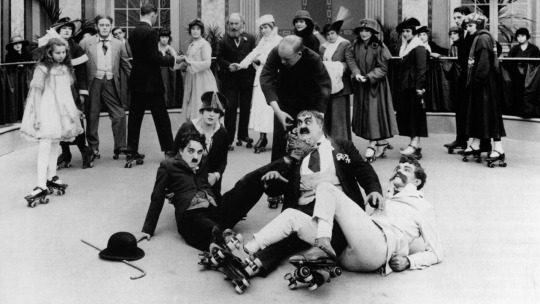
The Rink is a comedy where Chaplin really gets to show his strength at creating gags that continue to build, and his surprisingly strong roller skating skills. By this point, the tramp character is really coming into his own and Chaplin continues to invent new and exciting ways for him to be stupid. The specificity in the action and choreography make this occasionally feel more like a Keaton short than a Chaplin one.
9. One A.M. (1916, dir. Charlie Chaplin)
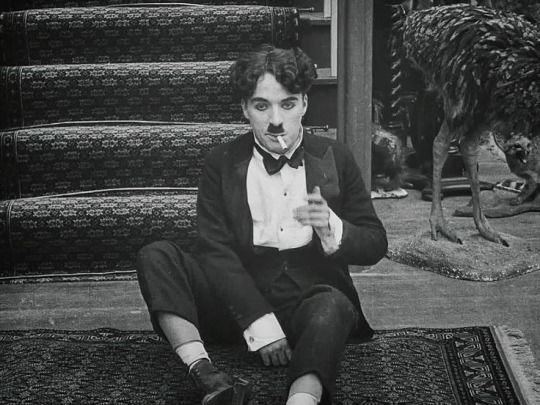
One A.M. is an incredibly interesting short for Chaplin as it's just him performing by himself on one small set. He plays some guy who comes home piss drunk at One A.M. and struggles to navigate the foyer of his own home. It really speaks to Chaplin's talent as a performer that this is as consistently entertaining as it is. Maybe there's something just primordially funny about people failing at simple tasks, but he seems to squeeze every ounce of potential out of this setup. It feels like this guy is Sisyphus if he was crushed by the weight of his own stupidity. Great stuff.
8. Coney Island (1917, dir. Roscoe Arbuckle)

While he's now remembered as one of the "big three" silent comedians, Buster Keaton got his start acting in smaller roles in films by and starring Roscoe "Fatty" Arbuckle, who was also funny in his own right. I would describe the plot here but it's pretty meandering and unfocused, all you need to know is Fatty is hiding around Coney Island. The plot being weak doesn't really matter in this kind of short, it's just a vehicle for gags which is all it needs to be. Adding a theme or moral to this through a more focused story would honestly bring the short down. There are some great gags here with Buster getting his girl stolen from him and Fatty crossdressing (something he apparently did a lot), as well as plenty of slapstick and humour derived from carnival games. It gets incredibly ridiculous and is not at all interested in being grounded or feeling real. This whole style is a nice change of pace compared to some other silent comedies that tried to be something they weren't. This is primarily interested in getting you to laugh, and it gets there in some quite impressive ways. Something I do want to note is that the original release of this movie has an extended ending which is super racist. Modern restorations use the later versions which cut this out, but it still exists and is pretty gross.
7. The Unchanging Sea (1910, dir. D.W. Griffith)

The Unchanging Sea is a much more emotional and subtle film than much of Griffith's later plot-focused work, however, the ways it stands out from the style he went on to refine in this decade is what makes it so interesting and memorable. It's really a film about longing and the quiet sadness and isolation women experienced in this time period. I've always maintained that despite him being behind on other groups (i.e. being a vile racist), Griffith's films were always much more feminist than his contemporaries. Perhaps his willingness to portray complex female characters with unique issues was a factor in his early success. For the women in The Unchanging Sea, the work of their husbands out on the open ocean transfers them to a liminal state, unable to tell if their lover and possibly only friend would return until the moment he did. The sea does not care for their sorrow and their concern, it's a force much greater and mysterious than any fight they could muster. The light plot here lets us sit in the anxiety of these women and understand the way that their experience of life is fundamentally limited by the circumstances they were born into. There isn't even any real way to protect each other, as the ways of love for a woman in this time and place are a force more powerful than their pleas for other women to stay alone and self-reliant. The Unchanging Sea is about how human connection is all we have yet for many it's a prison. It's a kind of story that was only possible by someone like D.W Griffith when he and film were in this more primordial state, more willing to experiment and craft experiences that differed from the stories pioneered by other mediums, and is a shining example of exactly why this period of film history is so worth returning to.
6. The Cook (1918, dir. Roscoe Arbuckle)

Don't worry, this post isn't all silent comedy shorts. But in said genre, The Cook stands above the rest. This one feels a bit more focused than Coney Island, I know I ranted about how a proper plot wasn't super important in that one, but it did still feel a bit too disconnected overall, where here there's a full funny throughline from beginning to end. Not a throughline that's really trying to say anything, just a method to build tension and add onto gags to make them the best they can be. There are a lot of setups that take quite a while to pay off, often with several gags in between them, as well as some gags that feel like Rube Goldberg machines. It's an impressive piece of work that clearly took a lot of planning and care to execute. It has workplace safety violations and a cute dog, what more do you want?
5. Dante's Inferno (1911, dir. Francesco Bertolini, Giuseppe de Liguoro, and Adolfo Padovan)
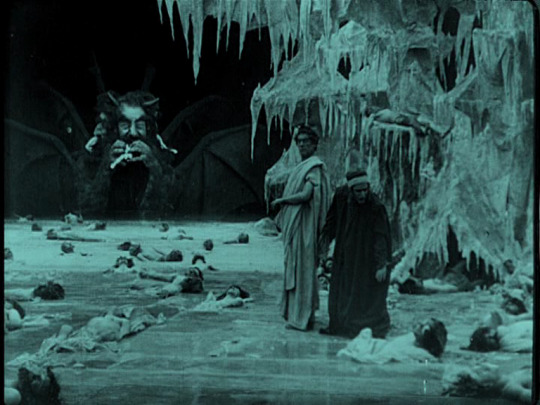
Dante's Inferno/L'Inferno is the oldest surviving feature film, and the first one ever produced in Italy. I hate to call a film "an experience" but it really applies here. The narrative simply consists of two guys wandering around hell for 70 minutes. It's just an excuse to look at some really gorgeous visuals. The sets and effects in this are gorgeous, and the film seems determined to keep outdoing itself in its scope and ambition. This is much more inspired by Meliés than the likes of Griffith. It's something you look at and take in like a painting. You really need to just appreciate the artistry and imagination. It doesn't work for everyone, I'd forgive you if you got bored, but for me, it's a wonderful and astounding piece of art, that exemplifies the facet of early film to portray sharp and impactful images.
I'm realizing now that I have much more to say about these films than I expected, even ones that didn't make it into the top 10. So I'll end this post here! Look forward to seeing the top 4 and a ton of honourable (and dishonourable) mentions.
6 notes
·
View notes
Text

[ID: A three-star review of "Elvis" by ankle-beez on Letterboxd that reads:
"was ready to give this 2 stars but the directing and last 30 minutes pushed it to the current rating for me
Genuinely do not think this would've worked without Austin Butler's incredible performance AND Baz's direction. Every bizarre cut and transition, every mesmerizing camera swoop, every insane needle drop (the DOJA CAT needle drop and the Toxic mashup made me lose my damn mind), every single decision that shaped this movie up to be the way it is is 100% integral to the type of story Baz wanted to tell. I can't say it's particularly any good but im glad it's out there and I'm glad this batshit vision made it out compromised. Studios should give Baz free reign to do whatever he wants every couple years
Also if Austin doesn't get an Oscar nom for this I'll burn everything down"]
#had a lot to say about this one hm.#elvis#elvis film#elvis 2022#elvis movie#my letterboxd reviews#angel.post
80 notes
·
View notes
Photo
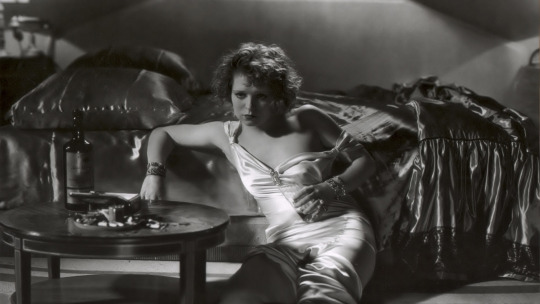
Savage Cinema.
From anarchists and adultery to milk baths and massacres, Matthew Turner shares five of the weirdest and wildest highlights of Hollywood’s pre-Code era, as #PreCodeApril comes to a close.
Pre-Code April was directly inspired by Noirvember, a month-long celebration of noir cinema instigated by Marya Gates (Oldfilmsflicker). I did Noirvember for the first time in November 2019, really enjoyed it, and thought it would be great to do the same thing for pre-Code movies. Although I’ve watched most of the classic 1930s films, I realised there were a huge number of pre-Code films I’d never seen (of my Letterboxd list of over 900 Pre-Code films, I have only seen 200).
As a sucker for a bit of wordplay, no matter how tenuous, I picked April partly because it’s six months away from Noirvember and partly because of the shared “pr” sound in April and Pre-Code. I’ve been absolutely delighted by the response—the #PreCodeApril hashtag on Twitter is a daily treasure trove of pre-Code-related joy, but I was genuinely thrilled to see the response on Letterboxd (here is my watchlist for the month). It’s been a real pleasure to see pre-Code movies constantly popping up in my ‘new from friends’ feed. My hope is that it’ll be even bigger next year—and that maybe TCM will want to get involved, the way they do with Noirvember.
Produced between 1929 and 1934, pre-Code cinema refers to films made in a brief period between the silent era, and Hollywood beginning to enforce the Motion Picture Production Code censorship guidelines (mandatory enforcement came in from July 1934). The “Code” in question was popularly known as the Hays Code, after then MPPDA president Will H. Hays. As the depression set in and box office declined, theater owners needed fare that would drive cinema-goers to the movies. It was a wild time to be a scriptwriter; they threw everything at the page, designers added even more, and actors played out the kinds of scenes, from the suggestive to the overt, that would otherwise be banned for decades to come.
The following five films demonstrate some of Hollywood’s craziest pre-Code excesses. They’re still jaw-dropping, even by today’s standards, and notably give female characters an agency that would be later denied as the Christian morals of the Code overruled writers’ kinks.

Madam Satan (1930) Directed by Cecil B. DeMille, written by Elsie Janis, Jeanie Macpherson and Gladys Unger
A critical and commercial flop in 1930, Cecil B. DeMille’s utterly insane musical comedy stars Kay Johnson as a straight-laced wife who plots to win back her unfaithful husband (Reginald Denny) by seducing him at a costume party, disguised as a mysterious devil woman. The location of this party? Oh, nothing too fancy, just on board a giant zeppelin. (“Madam Satan or: How the Film gets Fucking Crazy on the Blimp,” as Ryan reviewed it.)
Madam Satan is not by any stretch of the imagination a good movie (the editing alone is laughably bad), but as a piece of pre-Code craziness, it really has to be seen to be believed. Co-written by a trio of women and set in just three locations, it goes from racy bedroom farce to avant-garde musical to full-on disaster movie after a bolt of lightning hits the blimp.
The film is justly celebrated (in camp classic circles, at least) for the wildly over-the-top costumes paraded in the masquerade ball sequence, but there’s weird outfit joy everywhere you look. Keep an eye out for an enterprising extra who’s come dressed as a set of triplets.
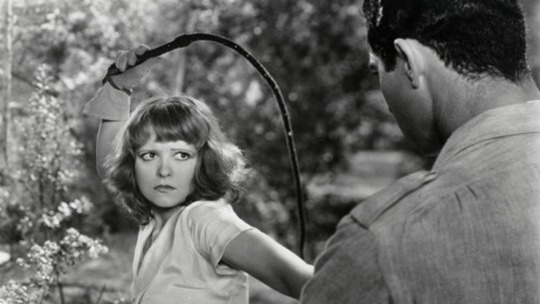
Call Her Savage (1932) Directed by John Francis Dillon, written by Tiffany Thayer and Edwin J. Burke
Adapted from a salacious novel by Tiffany Thayer, Call Her Savage was former silent star Clara Bow’s second-to-last film before her retirement at the age of 28. She plays Texas gal Nasa Springer, who’s always had a “savage” temper she can’t explain. In the space of 88 minutes she goes from wild teenager to jilted newlywed to young mother to prostitute to wealthy society girl to alcoholic before finally (it’s implied) settling down with her Native-American friend after discovering that she’s half-Native-American, something the audience has known all along.
Bow’s performance is frankly astonishing, to the point where you simply can’t believe what you’re seeing from one moment to the next. Sample scenes see her savagely whipping both a snake and her Indian friend, smashing a guitar over a musician’s head and violently wrestling her Great Dane… and that’s all in the first five minutes. She’s also frequently in a state of near undress throughout—one funny scene has her maids chasing her with a dressing gown because they’re afraid she’ll run down the street in her négligée.
The rest of the film includes alcohol, adultery, strong violence, attempted rape, murder, syphilis (not named, but heavily implied) and baby death. It’s a veritable smorgasbord of outrageous content and Bow is pure dynamite throughout. The film is also noted for being one of the first on-screen portrayals of homosexuality, when Nasa visits a gay bar in the Village frequented by “wild poets and anarchists”.

Smarty (1934) Directed by Robert Florey, written by Carl Erickson and F. Hugh Herbert
This deeply problematic sex comedy features pre-Code stars Joan Blondell and Warren William (often nicknamed ‘The King of Pre-Code’) at their absolute filthiest. Blondell plays Vicki, a capricious, happily married wife who gets an obvious kick out of taunting her husband, Tony (William). When he cracks and slaps her at a party, she divorces him and marries her lawyer, Vernon (Edward Everett Horton), whom she also goads into slapping her in a deliberate ploy to win back Tony.
Essentially, Smarty hinges on Vicki liking rough sex and it’s completely blatant about it, ending with her sighing “Hit me again” (the film’s UK title!) as they sink into a clinch on a couch, a rapturous expression on her face. It’s a controversial film because on the surface it looks like it’s condoning domestic violence, but it’s very clearly about Vicki’s openly expressed sexual desires—she wants to be punished and dominated, she just has a rather dodgy way of getting what she wants.
It might be unsophisticated, but in some ways Smarty is remarkably ahead of its time and ripe for rediscovery. To that end, it would make a fascinating double bill with Stephen Shainberg’s Secretary (2002). Oh, and it’s also chock-full of lingerie scenes (like most pre-Code films), if you like that sort of thing.

Massacre (1934) Directed by Alan Crosland, written by Sheridan Gibney, Ralph Block and Robert Gessner
Several pre-Code films (notably those made by Warner Bros) took a no-punches-pulled approach to their depiction of social issues, and star Richard Barthelmess actively sought out such projects. Here he plays Joe Thunderhorse, a Native American who’s become famous on the rodeo circuit. When he returns to his tribe to bury his father, he ends up fighting for their rights, taking on corrupt government officials and religious authorities.
Massacre is fascinating because on the one hand it’s wildly insensitive—Barthelmess and co-star Ann Dvorak are both cast as Native Americans—but on the other, it burns with a righteous fury and does more than any other Hollywood film (before or since) to champion the rights and highlight the injustices dealt out to Native Americans. That fury is encapsulated in a horrifying and rightly upsetting rape scene (it happens off-screen, but the cuts leave you in no doubt) that the film handles with surprising sensitivity.
In addition to being a passionate fight against racism and social injustice, the film also has some genuinely shocking sexual content. Most notably, Joe is seen making love to a rich white woman (Claire Dodd, who’s also in Smarty) who has an obvious sexual fetish, flaunting him in front of her friends and making a shrine in her room with Native-American paraphernalia.
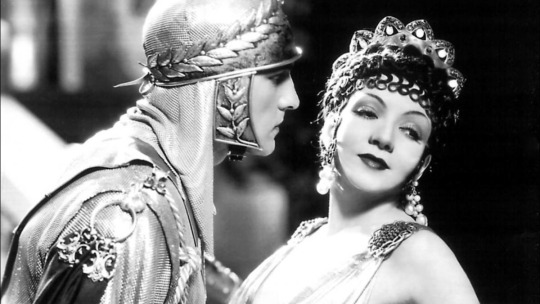
The Sign of the Cross (1932) Directed by Cecil B. DeMille, written by Waldemar Young and Sidney Buchman
Yes, this is Cecil B. DeMille again, but no list of weird and wild pre-Code films would be complete without the jaw-dropping ancient Rome epic, The Sign of the Cross. Adapted from an 1895 play by Wilson Barrett, it stars Frederic March as Marcus Superbus (stop sniggering at the back there), who’s torn between his loyalty to Emperor Nero (Charles Laughton) and his love for a Christian woman (Elissa Landi), while also fending off the advances of the Emperor’s wife, Poppaea (Claudette Colbert).
The film is racy enough in its sexual content alone: highlights include the famous scene of Claudette Colbert taking a nude milk bath and an erotic “lesbian” dance sequence, where Joyzelle Joyner’s “most wicked and talented woman in Rome” does ‘The Dance of the Naked Moon’ at Frederic March’s orgy, trying to tempt Landi’s virtuous Christian, to the obvious arousal of the gathered guests.
However, it’s the climactic gladiatorial-arena sequence that will leave your jaw on the floor. Lasting around twelve minutes, it includes: someone getting eaten by a tiger, a tied-up, naked women being approached by hungry crocodiles, pygmies getting chopped up by female barbarians, elephants stomping on heads, a gorilla approaching a naked woman tied to a stake, a man getting gored by a bull, and gladiators fighting to the death, complete with blood and gory injury detail.
The whole thing is genuinely horrifying, even for 2021. Best of all, DeMille pointedly critiques the audience (ourselves included), by showing a series of reaction shots ranging from intense enjoyment to abject seen-it-all-before boredom.
Matthew Turner (FilmFan1971) is a critic, author, podcaster and lifelong film fanatic. His favorite film is ‘Vertigo’. The films in this article are also listed here: Five of the Pre-Code Era’s Most Outrageous Films.
#preCodeApril#pre code april#precode april#hays code#mppa code#cecil b demille#clara bow#matthew turner#letterboxd#1930s films#1920s films#depression films
43 notes
·
View notes
Text
I watched all 26 episodes of an obscure Australian cartoon in one week and I’m not okay - My journey with Wicked! (2001) PART 1
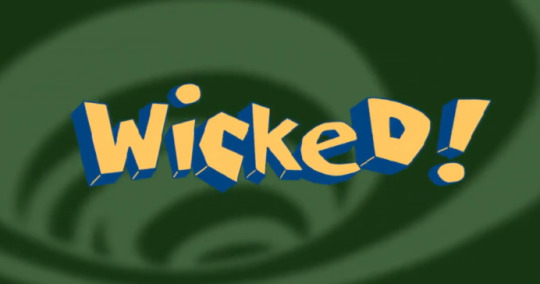
Here it is, the reason I started this blog in the first place. I need to talk about this cartoon I ran into completely by chance.
It all started, like you would, with Tubitv.
Good ol’ Tubi, the free streaming service that makes you either an expert at being able to find diamonds in piles of garbage or a connoisseur of said garbage. It’s thanks to Tubi that I put down that I watched Alpha and Omega: Family Vacation on Letterboxd for all to see and judge, but it’s also thanks to Tubi that I finally ended up watching Killer Klowns from Outer Space.
Anyhoo, one day I was browsing their family film selection when I ran into this selection. And that was the day my life changed forever.
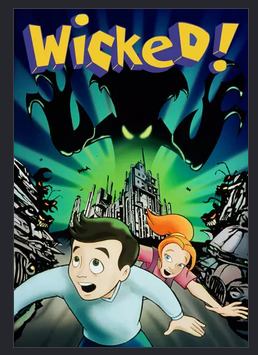
What you see before you, posted to a streaming service accessible in the United States, is the movie adaptation of an Australian TV show that never made it to the United States, which is based off a series of Australian children’s books from the 90′s that also never made it to the United States. It made it to other territories like Germany and the United Kingdom (and it apparently did super well in France but don’t quote me on this) but the TV show ran for one year and then disappeared without a trace after one 26 episode season.
How obscure is this franchise? Well, for starters, at the time I’m writing this in 2020, the books, the TV show, and the movie all don’t have a single Wikipedia page to call their own, and the easiest way to get info about this thing is to find the (rather tiny) TvTropes page.
Let’s just get right into this shall we.
What is Wicked!?
Before you try to be all cute and make any references to the hit musical, there’s a reason I’m putting that exclamation mark there.
Wicked! started out as a series of six children’s books written by Paul Jennings and Morris Gleitzman. I actually grabbed a kindle copy of all six books (because I’m in this thing too deep and I wanted to see how the cartoon compared with the source material) and I gotta say, they’re very charming.
The best way I can describe them is that they’re in the kid horror genre, but they’re less Goosebumps and more The Weenies book series by David Lubar in terms of gore and child endangerment. Wicked! has some artful depictions of blood and gore, but in a way that can be digested by the grade school crowd.
Being a former child, I can proudly proclaim that I would’ve adored this series when I was younger. Just look at these covers!
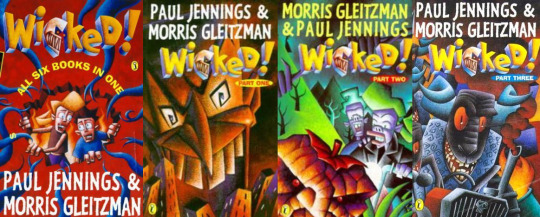
The plot of the books is that there’s a widower with a daughter and a divorced wife with a son who get married, and the two new step-siblings Rory and Dawn absolutely hate each other. They can’t stand the fact that their parents are getting married! Gross!
But then, on the day of their wedding, creepy things begin to happen after Rory receives an appleman doll in the mail, and then, over the course of six books, a deadly single-minded virus that feeds on hate and is targeting Rory’s bloodline begins to spread across wildlife, creating crazed mutant animals that try to kill everyone in the household. It’s up to Rory, Dawn, and Dawn’s grandfather Gramps to stop this virus before it kills Rory and his mother, and to do so, they have to seek out Rory’s father, who seems to be the mysterious cause and/or the solution to the virus.
I’m not sure how well these books did, on account of the whole “not Australian” affliction I seem to suffer from, but they seemed to do well enough to get a TV show adaptation.
And surprisingly, the TV show is a very close adaptation of the books, only they changed the plot in two big ways so that it fits an animated series with a “monster of the week” setup.
The first big change was that, of course, they toned down the blood and gore and removed the deadliness of the virus, choosing to go with a more cartoony mutagenic approach. Rory gets infected by the virus several times in the show, just like how he does in the books, but unlike the books, he never thinks that he’s going to die from it and it’s definitely treated as a more temporary thing. There’s no race against time either. Everyone is trying to live their lives except every so often, the virus shows up. A wacky cartoon virus with cartoony stakes.
That brings me to the other main change that they make in the show. Unlike the books, where the main villain is a mindless virus that feeds off of hate, an invisible foe that can only be defeated at the end of the last book with the help of Rory’s father, the TV show decides that that’s no fun and instead makes a main villain out of one of the main plot points in the books. Say hello to The Appleman. (Apple-Man? Apple Man? Fuck it, I’m going with the first one from now on)
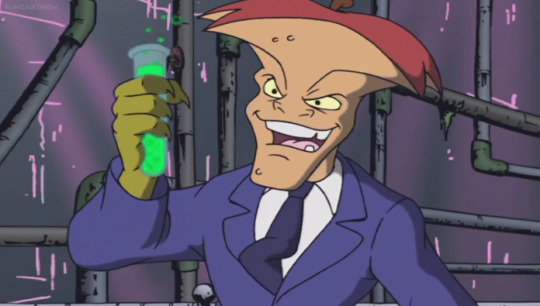
Instead of having the virus mutate mysteriously and having the main characters constantly hypothesize what’s going to happen next, the TV show made a main villain who constantly reinvents new strains of virus in a laboratory that he set up in an abandoned refinery.
What then happens is a basic plot set-up that the show follows pretty consistently in every episode. The family is trying to do something, we get the theme for the episode, and The Appleman, who is a spiteful bastard who is trying to ruin this one family in particular (and I’ll get to that), decides to make a virus that will infect the theme of that episode.
Pretty standard cartoon stuff, right? Ah, but then you don’t realize the beauty of this show. But first, I gotta introduce the main stars of this show.
The Characters
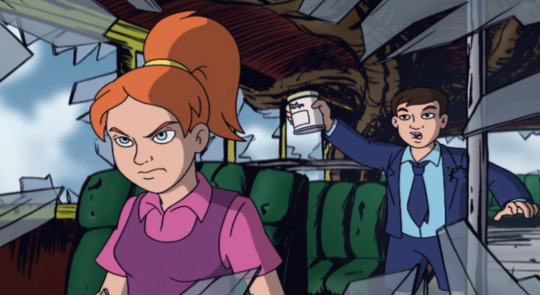
(quick note: this bus is incredibly important to the plot, but only in the books)
First we have Rory (the boy holding up the tin) and Dawn (the mad red head).
Dawn is the step-sister who lost her mom, a bus driver, in a gruesome bus accident, Rory is the step-brother whose parents got a divorce and then his dad went missing, believed to have run away from his whole family. Both of them are meant to be the dual protagonists, but I feel that there’s just a tiny bit more focus on Rory. There’s a reason for this that I will mention later.
What is interesting to note is that they make Rory the smart, non-athletic little nerd that gets picked on a lot at school for being a dork while Dawn loves sports, is failing science, gets made fun of for not being as girly as the other girls in her class, and likes violent computer games. I wouldn’t exactly call them “fleshed out” but they did enough to make these kids feel like actual kids.
Also, they fight. Constantly. This is the main complaint of anyone who actually looks into this show judging by my brief skimming of Internet comments because these two constantly bicker and insult each other and that makes up like 40% of the dialogue in any given episode. While this is one of the main story conflicts and they’re like this in the books too, it just feels super exhausting to see these two constantly at each other’s throats in every single episode.
They get mean too. Which, surprisingly, makes them both more realistic (I babysat multiple times and kids can be pretty verbally awful to each other) while also making them just a tiny bit unbearable at times. Here’s some actual dialogue.
"My dad sent it to me!" "Gee, he must think a lot of you to send you a doll full of worms." "Your mum thought so much of you she drove this bus over a cliff and into the river to get away from you."
GEEZ, guys...
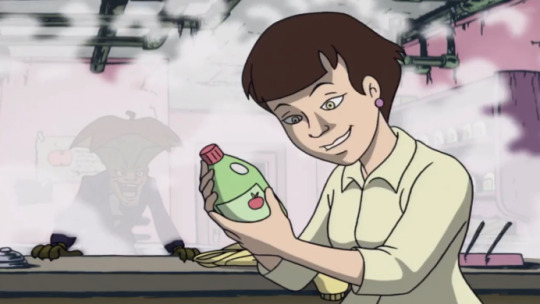
Eileen, Rory’s mom.
It feels out of the three adults in the family, she gets the least amount of character development, but she does get a fair amount of screentime, so you can’t really say they’re intentionally ignoring her. She divorced her previous husband and works as a mail courier. Instead of owning a car, she drives a motorcycle, and, in the first episode, even drives it to her own wedding while dressed in a bridal gown. Rory’s mom rules.
She tries to bond with Dawn because she always wanted to raise a daughter, but Dawn clearly doesn’t like her new stepmom very much. Dawn is also afraid of the motorcycle and it comes up a couple times in the show.
Eileen is the adult that gets targeted the least by The Appleman’s schemes. There’s a very pointed reason for this, and I swear, I’m getting to it soon.
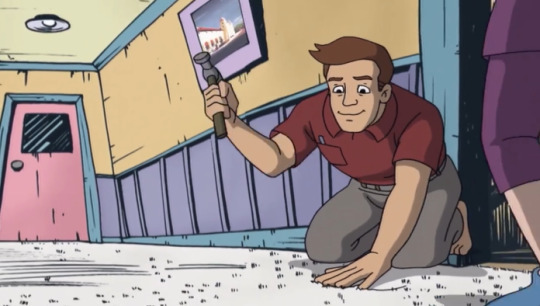
(quick note: yes, the show uses real photos to put in picture frames in the backgrounds and it’s real weird and never addressed)
Jack, Dawn’s dad.
Jack is a sheep shearer, just like in the books, and he’s a big easy-going dope that is hard not to love. Look at him hammer in this carpet. A true champ.
Out of the three adults in the family, he seems to be the one that nearly dies the most, with The Appleman going out of his way to specifically target Jack in some episodes. If you know Appleman’s backstory, this reads as absolutely petty spite and I love every minute of it.
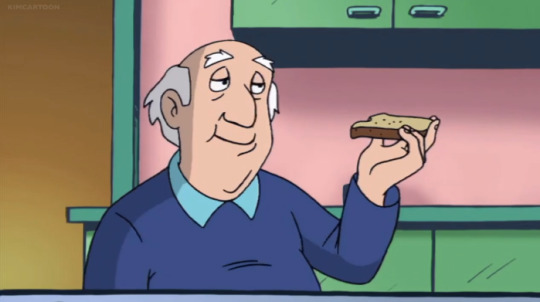
Gramps, Dawn’s grandfather and Jack’s dad.
He’s an aging WWII veteran (one that has killed people in combat no less) who radiates constant Boomer vibes and, unlike Eileen and Jack, he actually sees some of the crazy shit that happens and will sometimes sense when something is infected with virus when the other two adults can’t.
In the books, he’s suffering pretty badly from dementia, but thankfully the cartoons drop that completely. I’m glad too, because I don’t have the confidence that they would’ve written it with enough sophistication to make it not seem ableist. Instead, he’s just your typical kooky cartoon grandfather.
He’s probably the adult that gets the most screentime because he will actually help Dawn and Rory out. Again, this ties into the books, where he was the main adult ally for the kids.
He says a lot of army-themed catchphrases. It’s a tad overplayed but it never really gets to a point where I would call it “annoying”. Also, instead of living in the house, he lives in a tiny granny flat on the property. Sometimes Rory spends the night there.
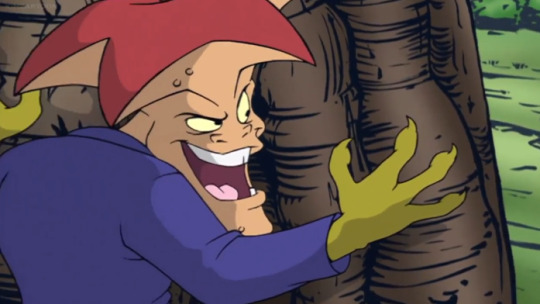
Last but not least, we have the star of the show, and the reason why the easiest way to find information of this show is to google “Wicked The Appleman”.
The Appleman, as explained, is the main villain of the story. Dressed in a very fancy suit complete with dress shoes and a nice blue tie, he lives in an old refinery full of rats, bats, and giant worms (called Slobberers), and he’s rocking a voice that can be best described as “Australian Mark Hamil” with an absolutely heavenly evil laugh. He has gross clawed hands, a rotten apple for a head, and likes making people miserable, because he’s basically the living puppet for a virus that feeds off of negative emotions. The main goal of each episode is to either defeat him or to stop the mess he’s made. Usually both.
Since all of his minions are non-sentient animals, a lot of his dialogue is him lurking behind something while he monologues to himself, sometimes turning it into a creepy little rhyme. He’s a pretty lonely guy, so him hanging out with this family can be seen as a very non-subtle cry for help.
The best episodes are the ones where he tries to lurk about in public with a very poor attempt at disguising his hideous features. Somehow it always works, you know, despite the fact that he has yellow eyes, the skin like a moldy apple, and no ears.
What Makes Wicked! Unique
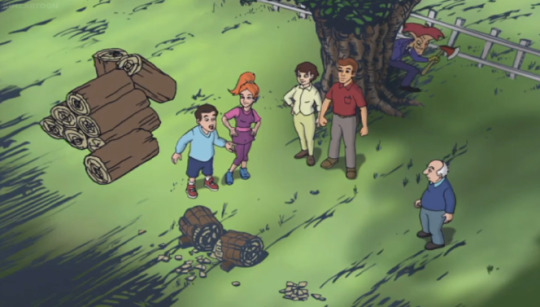
(no, The Appleman doesn’t actually use that axe)
The first thing this show does that most of the formulaic shows don’t do is that it does, in fact, have a beginning, a middle, and an end. That’s why this show was packaged into a full-length movie - you can glue scenes together and actually make a pretty decent narrative, even if the resulting movie definitely had a “glued together TV show episodes” feel ala some of the bad Disney sequels like Cinderella II and Atlantis II.
This show even has some plot-heavy episodes that dive into just why this whole Appleman situation is going on and why he seems to have it out for this one family in order to flesh out the characters more.
Because that’s a thing that this show does. The Appleman is a cartoon-y villain who cackles in his lab and constantly invents new strains of viruses that can mutate things like animals and household appliances, but he doesn’t do it to take over the city or to “destroy the world”. He does it purely to inconvenience this one Australian family, who he stalks pretty regularly. This is a thing that comes from the books and honestly, it’s a thing that elevates Appleman from “ugly-looking cartoon villain” to “pretty damn creepy, if also still cartoony in execution”.
Sure, a lot of cartoon villains target the main protagonist in their evil schemes, but this one is definitely more personal.
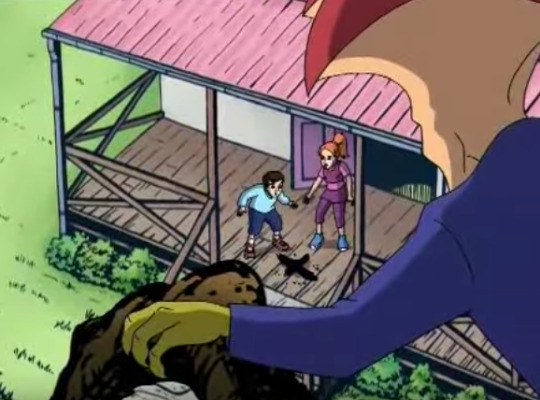
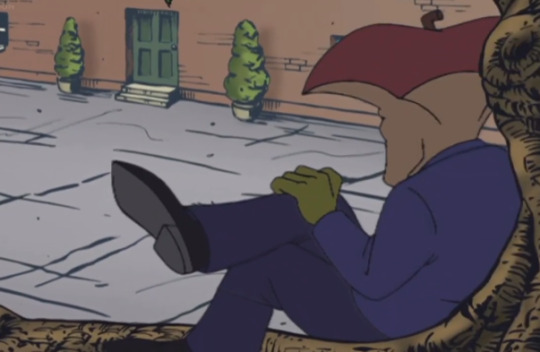
He regularly follows Rory and Dawn to school and, when the family goes on a camping trip, he comes too. If Rory decides he’s going to hang out in the wrecker’s yard, The Appleman will be cackling and hiding behind totaled vehicles. If Gramps takes the kids out to the bay to go fishing, The Appleman will pull an ice cream truck out of his garage and follow them there. That’s how the main conflict is really set up.
I think if a scarier cartoon tried, they’d make him out to be this grotesque stalker, but instead, since this show is kinda goofy in execution, he’s like the shittiest cryptid in the world, constantly crouching behind trash cans and on top of rooftops while constantly cackling about how clever he is and how, miraculously, no one notices anything’s amiss.
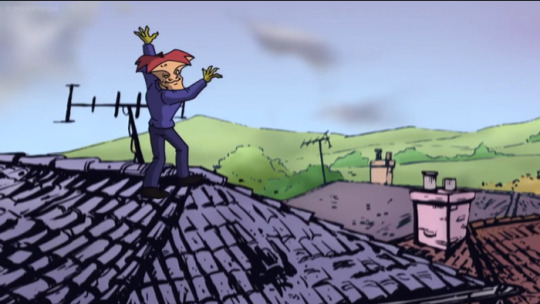
This alone would make this villain interesting, but then they set up something about this show at the beginning if you watch the intro and the first episode and put two and two together.
Right from the start, the opening shows that The Appleman was once human by depicting his transformation by the virus. They don’t even try and pretend that he’s some demon or some sort of supernatural monster - he’s specifically a blue collar worker who had a nasty run-in with fate and mutated into this hideous apple-headed creature that now has to hide out in an abandoned refinery. You see why he’s dressed like that - he’s still wearing his work uniform.
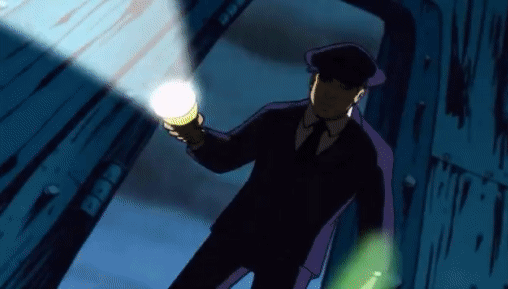
Right after you watch that intro, the first episode of the show has Rory receiving a mysterious package from his father on the day of his mother’s wedding. It’s the first time that Rory and his mom Eileen have heard from their dad after he mysteriously vanished years ago.
What’s inside? An apple-headed doll, which contains the first virus-infected monsters, The Slobberers.
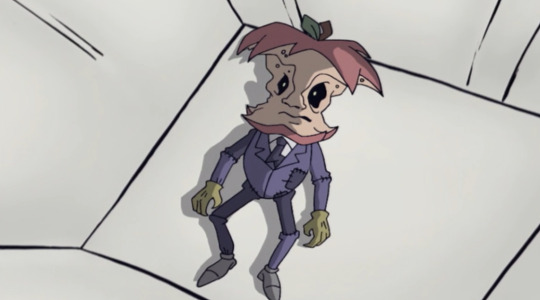
When The Appleman makes his first dramatic appearance, he never says Dawn’s name, but he does know Rory’s name.
And, in case you didn’t pick up the hints from the first episode, the fourth episode really drives it home without spelling it out. Then the last episode of the series decides to say it out loud.

That’s right. Rory’s father, the man who mysteriously vanished from Eileen and Rory’s lives, is still an important part of the cartoon’s storyline, but instead of being the man who appears in the last book that knows how to cure the virus while also being the first victim of the virus, he’s the main antagonist.
The Appleman is Rory’s father.
And honestly, because of this little plot point, this show becomes a much richer experience once you look at the unhinged appleman who keeps unleashing horror on these kids and realize that he’s a divorced dad who constantly keeps tabs on his ex-wife's unstable dysfunctional family in order to make them more pissed at each other because that feeds the virus that mutated him.
This is a very cool concept. This is where Wicked! shines when, for all intents and purposes, it is otherwise a pretty average turn-of-the-century Australian cartoon that can be best described as “it’s okay, I guess” in terms of quality.
Because that’s really the rating I can give this show. It’s Okay.
It’s a very solid Okay, but I think any adjective more powerful than “Okay” is really pushing it. It’s not Great, it’s not Amazing. It’s Okay. Alright. Kinda Good.
But man, is it a wild ride.
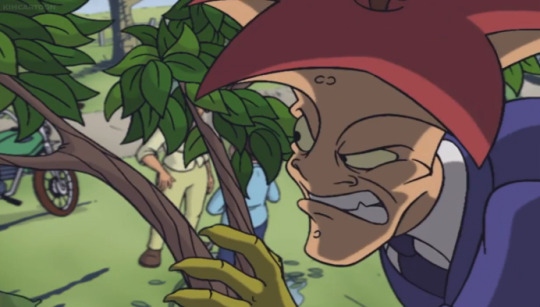
Next time, I’m going to start discussing the actual episodes as well as this show’s pros and cons. Dividing this up into multiple parts partly because I feel like these things are more easily digested in smaller chunks and partly because I’m pretty sure tumblr now has a size limit on posts soooo...yeah.
Follow this handy link for Part 2 - The Actual Review!
19 notes
·
View notes
Text
The 10th Annual L.A.O.K. Awards
Wow. Ten years of the Layokies. What a trip. I would like to give my heartfelt thanks to all five of my faithful fans for your readership over the years. In my first ever Layokies post, I named it the “1st (Possibly) Annual L.A.O.K. Awards.” I had no idea how long I’d be working at the Academy, let alone living in LA, but here we are. I bragged about seeing 180 movies that year. I just checked my Letterboxd stats for this year and it turns out I watched...180 movies. However, this year I hit a new personal best for new releases: 125. While this is about half as many as some people I know, some of the first Layokies were based on a field of 60 or 70 movies, so I’ve doubled up on my old self. Funny thing is, I can still look on other year-end lists and find many films I haven’t seen, and even some I haven’t heard of, so the field of films I’ve added are probably in the middle to bottom range of the pack. But someone out there has to watch��Tolkien, Gemini Man, The Goldfinch, and Where’d You Go, Bernadette?, so it might as well be me.
In all honesty, my absolute favorite thing about living in Los Angeles and working at the Academy is access to watching movies and being around the general cinephile community, and even a bad couple of hours in a movie theater beats a lot else. Over Christmas break I saw Star Wars: The Rise of Skywalker in Shawnee, OK’s own Cinema Center 8.

It was quite a trip going back to this theater after so many years and to think of the love of film that was fostered there. Alas, the picture was pretty muddy, and I’m almost positive they showed it in 2k. ¯\_(ツ)_/¯
Now, in penance for naming The King’s Speech Best Picture in my first year (lol), I give you five real good’uns for 2019:
Best Film The Farewell The King Little Women Parasite Uncut Gems
Sometimes I touch on a year being good or bad for film in general. Not sure about the whole, but I’ll call 2019 a real SEC year (aka stacked at the top and mediocre to poor the rest of the way down). While I would probably only give one title on this list must-see status (Parasite), these are all definite should-sees. The Farewell made me laugh and cry and cringe. One might even go so far as to say it “gave me all the feels.” The King gave me actual siege warfare and period-accurate haircuts. Little Women hit me with that structure, and at first I was all “hol up,” but then I was all “OK I see you.” Little Women also made me cry because I cry in movies now. (A quick aside, because while I absolutely loved Little Women, it’s not really going to come up again. If you liked the movie and haven’t read the book, please do yourself a favor and make it the next one on your list. You can’t know how great this movie is unless you know how good Beth is. Beth kind of got lost in this one, and you need to know Beth.) Parasite blew me away through its normality (who, having seen The Host, Snowpiercer, and Okja could have guessed that it wasn’t about some actual alien parasite??). And Uncut Gems was exactly as perfect as I expected it to be. And the Layokie goes to... The King

Faithful readers will know that one of my absolute favorite genres is ‘discreet conversation behind castle walls,’ and The King absolutely nailed it. It has everything: leadership position foisted on a worthy but flawed character who doesn’t want it, conversations in tents about battle tactics, love built on almost nothing but mutual respect, and most of all, Robert Pattinson doing a funny accent (it’s just a French accent, but he makes it quite funny). I would have already watched this again five times on Netflix, but I’m hoping and praying for an Oscar nomination that will never ever in a million years come in hopes that I can see it again in the theater during nominations screenings.
The Next Five Six 1917 Honey Boy The Laundromat The Lighthouse Marriage Story Portrait of a Lady on Fire
Best Actor Timothée Chalamet - The King Adam Driver - Marriage Story Paul Walter Hauser - Richard Jewell Joaquin Phoenix - Joker Adam Sandler - Uncut Gems
Another super stacked category this year. You might even say they’re *puts on sunglasses*...Stacked Actors. (<-- This is a really good joke for anyone whose favorite band from 7th-8th grade was The Foo Fighters.) These are all kind of obvious, so I’ll take a second to comment on Paul Walter Hauser and the fact that I gave out a very specific award last year titled “Refuse to Watch - Any More Clint Eastwood Movies” after trying and failing to watch The 15:17 to Paris on a plane (one of the worst pieces of filmmaking I’ve ever witnessed). Then this year Richard Jewell was getting such good buzz, and it seemed like such a good cast, and it was such a low-risk watch (on my second screen at work while doing spreadsheets), that I decided to shamefully renege on my earlier pronouncement and give it a shot. And...it was great pretty good! What is the deeal with Clint Eastwood?? He’s made some of my least favorite movies of the decade (Gran Torino, Invictus, Hereafter was a particularly awful stretch, Sully was pointless, and even parts of American Sniper, which was otherwise tolerable, were absolute cringefests). Anywho, I was very impressed by Paul Walter Hauser’s understated but perfect performance, in which he gets one good chance to blow up and yell at people--which you know I love. I hope he gets nominated, because it would be a great Oscar clip. (My ultimate dream job would be to pick the acting Oscars clips and I would be very very good at it.)
And the Layokie goes to... The Sandman (love that everyone is calling him the Sandman again)

I touched on Adam Sandler “A” in the Best Supporting Actor section of my 2018 Layokies post regarding his performance in The Meyerowitz Stories, lamenting that he hadn’t taken more dramatic roles after Punch-Drunk Love and hoping that good writer/directors would keep casting him. One more wish granted by the Safdie brothers. Adam Sandler’s talent is undeniable. He is truly one of the Great Actors of his generation. I really hope this is a respected-actor-making turn for him, but the upcoming roles on his IMDd--Hubie Halloween and Hotel Transylvania 4--don’t give much hope for the immediate future.
Honorable Mentions Taron Egerton - Rocketman (but only for the phone booth scene) Shia LaBeouf - The Peanut Butter Falcon Noah Jupe - Honey Boy Robert Pattinson - The Lighthouse Jonathan Pryce - The Two Popes
Best Actress Ana de Armas - Knives Out Scarlett Johansson - Marriage Story Elisabeth Moss - Her Smell Florence Pugh - Midsommar Saoirse Ronan - Little Women
Found out last night from my resident celebrity expert Bridgette Smith that Florence Pugh is dating Zach Braff and it absolutely crushed me.
And the Layokie goes to... Elisabeth Moss - Her Smell

Her Smell was the last 2019 film I watched before writing this post, and I was really just looking for something to pass the time. I had been wanting to see it for a long time and noticed it was on HBO, so I pressed play and planned to work on this post while I watched. I couldn’t. I was riveted. The writing, score, and sound design are incredible, but it’s all tied together by Elisabeth Moss’s performance. She’s excellent at being revolting but still has all of those qualities that made her Peggy. You can’t not like her, even though you fairly hate her.
Honorable Mentions Awkwafina - The Farewell Cynthia Erivo - Harriet Lupita Nyong’o - Us (You know I love weird voices, you know I love actors doing weird voices and faces, but this was a bit much even for me. Reflective of Us on the whole, which I thought was interesting but really missed the mark.) Charlize Theron - Bombshell
Best Director Ari Aster - Midsommar Bong Joon Ho - Parasite David Michôd - The King Benny and Josh Safdie - Uncut Gems Céline Sciamma - Portrait of a Lady on Fire
And the Layokie goes to... Benny and Josh Safdie - Uncut Gems

Wired: New directors Tired: Old directors
Boy do I not understand the love for The Irishman and Once Upon a Time in Hollywood. I’m not totally against boring movies if there’s a good reason for it (Midsommar was actually quite boring), but these were some of the least compelling films I watched all year. On the other hand, you have these young directors coming out of prestige horror, Ari Aster, Robert Eggers, and to a lesser extent David Robert Mitchell and Trey Edwards Shults, making some of the most dynamic films out there. Reminds me of Roger Ebert talking about early Scorsese in Life Itself (which I can’t find a clip of). Then you have Benny and Josh Safdie doing Scorsese better than Scorsese with literally breathtaking shots like the one below. How they construct such amazing edits out of such disparate takes as the one in the still above is a wonder. They’ll go from five extreme close-ups in a row to a jaw-dropping shot of the inside of a jewelry store zoomed in from across the street. And that’s just the tip of the iceberg on what makes them the best filmmakers working right now.

Honorable Mentions Noah Baumbach - Marriage Story Robert Eggers - The Lighthouse Claire Denis - High Life Greta Gerwig - Little Women Alejandro Landes - Monos Sam Mendes - 1917 Alex Ross Perry - Her Smell Joe Talbot - The Last Black Man in San Francisco Lulu Wang - The Farewell
Best Supporting Actress Laura Dern - Marriage Story Lena Headey - Fighting with My Family Lee Jung Eun - Parasite (The housekeeper) Meryl Streep - The Laundromat Shuzhen Zhao - The Farewell (Nai Nai)
And the Layokie goes to... Laura Dern - Marriage Story
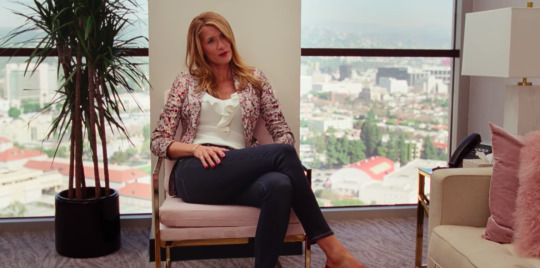
Here’s one for the Laura Dern stan accounts: There’s no question that Noah Baumbach is a talented director of actors, but Laura Dern makes so much out of seemingly not a lot in this role. She truly embodies a wholly unique and three-dimensional character that could have extremely easily been one-note.
Honorable Mentions Lily-Rose Depp - The King Florence Pugh - Little Women Margot Robbie - Bombshell
Best Supporting Actor Timothée Chalamet - Little Women Willem Dafoe - The Lighthouse Shia LaBeouf - Honey Boy Al Pacino - The Irishman Robert Pattinson - The King
And the Layokie goes to... Willem Dafoe - The Lighthouse

For being all: https://www.youtube.com/watch?v=xT7uR4wNMJs
Honorable Mentions Bill Hader - It Chapter Two Tim Heidecker - Us Sam Rockwell - Richard Jewell Song Kang Ho - Parasite (the dad) Lakeith Stanfield - Uncut Gems
Best Original Screenplay The Farewell - Lulu Wang Her Smell - Alex Ross Perry Marriage Story - Noah Baumbach Parasite - Bong Joon Ho Uncut Gems - Benny and Josh Safdie
And the Layokie goes to... Parasite - Bong Joon Ho

Another genre we don’t get nearly enough of: comedies of errors. A script like this is as sophisticated as any mystery, political thriller, or...some other sophisticated type of script, like uh, I don’t know, they usually just say Chinatown or Witness. I did think it lagged a bit in the third act, but everything that came before it was so tight. Twist after turn after twist, so funny, so shocking. This is such a rare prestige crowd-pleaser that it really does harken back to Hitchcock; if a wide audience can get over watching subtitles, this has to have one of the lowest barriers for entry of any foreign film in a long time. Here’s hoping for a Best Picture Oscar nomination and a wide release. Uncut Gems played at Shawnee’s other theater (titled simply Movies 6), so it’s not that far out of the realm of possibility. But I know people in LA, even that work at the Academy, who won’t watch subtitled films, so getting people to actually go see it is another question.
Honorable Mentions Peterloo - Mike Leigh
Best Adapted Screenplay Jojo Rabbit - Taika Waititi Joker - Todd Philips & Scott Silver The King - David Michôd The Laundromat - Scott Z. Burns The Two Popes - Anthony McCarten
And the Layokie goes to... The King - Joel Edgerton and David Michôd
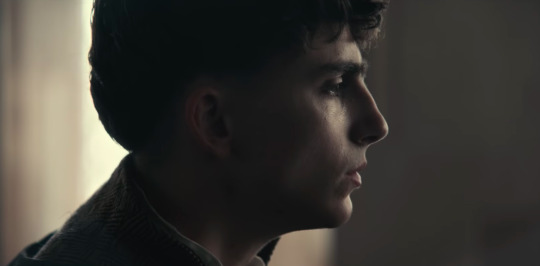
It wouldn’t be the Layokies without me championing one film that no one else cares about. I just really really liked The King. Timothée Chalamet is so hot right now! How did this get so overlooked?? 😭
Best Documentary Apollo 11 Honeyland It’s a Hard Truth Ain’t It Maiden Mike Wallace is Here
And the Layokie goes to... Maiden

As I’m in the process of producing a documentary right now, it pains me a bit that my top two picks in this category are almost entirely archival. I thought Mike Wallace is Here was so well done, and the director did some amazing things playing with aspect ratio. But Maiden came into port first. What is wrong with people who don’t appreciate sports? This xkcd comic (who I usually appreciate) makes me so angry. Tell the women who worked their asses off for years to claw their way into this male-dominated space and literally made the world a better place that their efforts were no more than a weighted random number generator on which to build narratives! Clearly the narratives are there, but it rarely has as much to do with the result of the competition as it does the effort that it took individual human beings to get there. See also: Undefeated (currently streaming on Netflix).
Honorable Mentions Fyre They Shall Not Grow Old Satan & Adam
Best Foreign Language Film Duh Parasite
Biggest Missed Opportunity Pokemon: Detective Pikachu (How the first live action Pokemon movie should have happened)
Not Even Close to Enough Monsters Godzilla: King of the Monsters
Most Unbelievable Cosplay Tom Hanks as Mr. Rogers
Absolutely Crushing the Sensitive Dad Roles Billy Crudup in After the Wedding and Where’d You Go, Bernadette?
Good in Everything Too obvious, but Florence Pugh - Fighting with My Family, Midsommar, Little Women Robert Pattinson - High Life, The Lighthouse, The King Adam Driver - The Dead Don’t Die, Marriage Story, The Report, Star Wars: The Rise of Skywalker
Destigmatizing Fatness Award Dolemite is My Name The Laundromat Skin Almost Hustlers but then not (Lizzo got what, 30 seconds of screentime??)
#WasteYourAudience’sTime2019 The Souvenir The Proposal
Didn’t Actually Deserve to be Driven into the Ground Dark Phoenix The Kitchen
Just Plain Liked It Triple Frontier
Most Forgettable Tie: Tolkien and High Life (not for me, but it took me a full 10 minutes to convince Becca that she watched this, and I had to describe the masturbation chamber aka fuck box in a lot of detail before she got it, and I’m still not totally convinced she remembers it)
The Something Award Motherless Brooklyn
The Nothing Award Judy
Worst Movies 1. Rambo: Last Blood 2. Between Two Ferns: The Movie 3. Abominable 4. The Lion King 5. Godzilla: King of the Monsters 6. Wine Country 7. Jumanji: The Next Level 8. Frozen II 9. The Goldfinch 10. Pet Semetary
Best Scenes
Avengers: Endgame - The hammer, the portals, all the nerdy/normie BS, what can I say call me a basic bitch but there were some genuine holy schmoly moments in this that made it a really fun movie to experience in the theater
A Beautiful Day in the Neighborhood - When Mr. Rogers uses the puppets on Lloyd
Captain Marvel - When she went full shit on ‘em
Climax - The opening dance sequence (the only thing that made this movie worth watching)
The Farewell - Too many to choose from, but I think my favorite moment in this movie was when they were taking photos of the fiances and another couple stumbled in on them, claiming they were lost. That couple leaves and we never see them again. These are the kinds of details that make movies come alive. Absolutely brilliant.
Gemini Man - The motorcycle chase (a rare scene actually made better by the high frame rate)
John Wick: Chapter 3 - Parabellum - The knife fight in the knife store
The King - The conversation between Hal and Catherine
Knock Down the House - When A.O.C. debated the incompetent proxy
The Last Black Man in San Francisco - Skateboarding into town
Little Women - The “break-up” scene between Jo and Laurie (not a spoiler)
Midsommar - The drug trip scene (not that I’ve ever done drugs but this was the most accurate drug trip scene of all time) and the Ättestupa ceremony. Also found out in the video linked above that Ari Aster pronounces it Mid-SO-mar?? I thought that was the dumb way to pronounce it but apparently I’m the dumb one. Also also, another amazing detail worth mentioning: I absolutely loved that every time they were in their community sleeping barn, there was a baby crying somewhere on the second floor that we never see. Such a perfect way to put the characters and the audience on edge and indicate that there’s something wrong here.
Once Upon a Time in Hollywood - While I didn’t care for this movie, the scene where Brad Pitt went to the movie ranch and when he fantasized about going to the film set were absolutely dripping with tension, which made them as just as riveting as the rest of the movie wasn’t
Parasite - When the other family comes home early
The Peanut Butter Falcon - The scene after they come out of the corn field and share one of their first genuine moments
Uncut Gems - *Sarah Palin voice* All of ‘em, any of ‘em. But seriously the finale with the Celtics game
Us - The initial home invasion and the visit to the Tylers’ home (Tim Heidecker and Elisabeth Moss)
The A.V. Club also does a best scenes list at the end of the year, and I love writing mine first and then seeing what they came up with. I’m always surprised at how many we match on. Just goes to show that a good scene is universal. I also enjoyed some of theirs that I overlooked here, including from Her Smell, Bombshell, Ad Astra (I almost included the moon chase myself and thought the baboon scene was equally compelling), and Portrait of a Lady on Fire.
Stupidest Scenes Every other John Wick 3 scene
Deserves Discussion The Dead Don’t Die
This movie was a lot of fun. But then it also completely sucked? Not really a Jim Jarmusch fan in the first place, but this had so many awesome elements to it: a great cast, great soundtrack, really fun and unexpected ways of breaking the 4th wall, but then it was also pointless and boring. I would love for someone to tell me why this is a good movie after all, but judging by its complete absence from the end-of-the-year discussion (or any discussion), I’m guessing no one cares enough to mount that challenge.
Best Visuals Alita: Battle Angel Aquarella A Hidden Life Honeyland Midsommar Monos
Many LOLs It Chapter Two Jojo Rabbit Parasite
Best Song Ready or Not - The Hide and Seek Song (why was this not submitted?)
youtube
Best Soundtrack Waves - Never have I already known so many songs on a film’s soundtrack; it’s almost as if Trey Edwards Shults is another white guy around my age with the same interests as me...
Worst Accents Midway
Started But Never Finished Cats Cold Case Hammarskjold Genndy Tartakovsky’s ‘Primal’ - Tales of Savagery The Highway Men High Flying Bird Queen and Slim Spies in Disguise
Didn’t See Ash is Purest White Atlantics The Beach Bum The Body Remembers When the World Broke Open (still really want to see this one) Clemency Diane Invisible Life Luce Shadow Synonyms Transit Woman at War
Absent on Purpose Pain & Glory Ford v Ferrari I think these are the only two contenders that I’ve seen and haven’t mentioned. I actually liked both of these movies quite a bit. Just didn’t stand out for me in any one category I suppose. But then also: Booksmart Brittany Runs a Marathon Just Mercy The Mustang
Hah!

0 notes
Text
The Greatest Year in Horror Film History PART I: 2017
New Post has been published on https://nofspodcast.com/greatest-year-horror-film-history-part-2017/
The Greatest Year in Horror Film History PART I: 2017
Question: What is the greatest year in horror film history?
Answer: LOUD SCREAMING
I don’t blame horror fans for the passionate debates we get into. It’s almost impossible to be totally objective with a question like that. The most important and invaluable aspect of art is its subjectivity. It creates the possibility for different viewpoints, allowing for discussion and (sometimes) healthy debate. Every person, whether they mean to or not, has an opinion on the pieces that they come across. Sometimes, however, this debate can spiral into a cycle of nastiness that prohibits the free expression of ideas and views.
Horror is no exception. We watch, discuss and rate each movie that we watch, trying to determine its place in the pantheon of great horror cinema. Websites such as Rotten Tomatoes and apps like Letterboxd allow us to share our thoughts and start discussions with other fans about the merits of each film we rate. The problem with these discussions, however, is the very subjectivity that makes art so important. No one can be either “right or wrong”. The conversation often devolves into name-calling and hurt feelings, effectively shutting down our willingness to share our views in the first place. What we need, as a community, is to answer some of these questions once and for all so that we can get back to discussions about how to improve the genre.
You’re in luck, Fiends! We have taken the numbers into consideration and come up with a definitive answer to the question on everyone’s mind at the end of the year. Which year, officially, is the greatest year in horror film history?
OUR METHODOLOGY OR: HOW WE LEARNED TO STOP WORRYING AND LOVE EXCEL
Here’s a quick rundown of how the rankings were decided:
We took a look at all of the horror films from 1970 to 2017. (The early 1970’s were a starting point for us because A) We needed one and B) The frequency of quality and iconic horror films really picked up during this time).
To determine a “score” for each year, we took a look at 5 different rating sources-
Rotten Tomatoes Tomatometer Score
RT Critic’s Average Rating
RT Audience Score
RT Audience Average Rating
IMDB Viewer Ratings
– These ratings were averaged to find the “Fiend Score” for each film. We then combined the Fiend Score of the top three horror films from each year to give that year a total. I admit, the selection of the top three films was sometimes difficult. It was necessary to take other factors into account, such as the size of release, box office total and iconic status to determine which films were included in the top three. These three films were totaled and given an official number which we are calling its “NOFS Score”. These NOFS Scores ranged anywhere from 142 (Ouch) to 255.
Over the next few weeks we will be counting down the years and finally reveal, once and for all, the Greatest Year in Horror Film History! This week, we will be discussing-
#3- 2017
NOFS Score- 239
Several journalists and publications, most notably The New York Times Magazine, have dubbed 2017 “The Year of Horror”. It was a blockbuster year, for sure, with horror films raking in over $1 Billion at the box office. Our official ranking, however, places 2017 at number three. How did we end up with this score? Here are the film with the top three Fiend Scores for 2017:
#3– Split
Written and Directed By: M. Night Shyamlan Starring: James McAvoy, Anya Taylor-Joy
Fiend Score- 73
As a devoted Shyamalaniac (TM), I couldn’t be happier about his resurgence these last few years. The Visit (2015), while not my favorite film of his, definitely showed that he is still very effective within the confines of a low-budget horror movie. Split was a huge success, bringing in over $278 Million for Blumhouse Productions, and it brought us one of the most satisfying closing scenes of the year.
James McAvoy and Anya Taylor-Joy’s performances make this film the joy to watch that it is. Without their work to back up the story, this film quickly turns into just another “girls trapped by a psycho” movie that we would have quickly forgotten about. Anya’s Casey deserves to be placed in the upper echelon of horror “Final Girls” because of her survival instincts and the quiet strength she shows in the face of a monster. With the confidence that he displayed in Split, I have no doubts that Shyamalan is back and will crush next year’s Glass.
#2– It
Directed By: Andy Muschietti Written By: Chase Palmer, Cary Fukunaga and Gary Dauberman Starring: Bill Skarsgard, Jaeden Lieberher and Sophie Lillis
Fiend Score- 80
Here lies my favorite horror film of the year. The first chapter of the new adaptation has grossed a staggering $695 Million at the worldwide box office, making it one of the top grossing films of the year. It has been written about extensively all over Nightmare on Film Street, so going over what the film is about is a bit redundant. Instead, let’s take a quick look at what made the film so successful.
Nostalgia can either be your best friend or it can be the death of your project. The expectations surrounding this film were immense and there was very little room for error for Muschietti and company. What stood out to me was how much of Stephen King’s vision the director was able to get on the screen. Yes, plot points were changed, scares were either combined or replaced and character roles were altered, but the essence of the story was left intact throughout the film. It did not focus solely on Pennywise (interpreted and played beautifully by Bill Skarsgard), but instead followed our Loser’s Club as they each dealt with the Clown and the demons in their personal lives. It was a film that reminded us all about how important those early friendships were, and helped us all to remember those that helped us fight the Dancing Clowns in our own lives.
#1– Get Out
Written and Directed By: Jordan Peele Starring: Daniel Kaluuya, Allison Williams, Bradley Whitford
Fiend Score- 86
It may have been my favorite, but Get Out was the most important horror film of 2017. Jordan Peele delivered, in his directorial debut, a tightly-wound thriller that not only delivered the scares, but also started important conversations about race relations in the United States. The film featured a standout performance by Daniel Kaluuya and grossed a very impressive $254 Million at the box office.
The most effective parts of Get Out happened before we even knew what was going on in the film. We obviously knew that something was amiss with the Armitage family, we just weren’t sure what it was yet. It has been years since I have felt as uncomfortable as I did during the outdoor party scene, and it was my favorite horror moment of 2017. The interactions between the older guests and Kaluuya’s Chris were dripping with subtle racism, whether it was how they changed the way they spoke in front of him or the need for one of the guests to mention Tiger Woods. These interactions can be brushed off as out-of-touch old folks just being uncomfortable, but then the bidding begins.
It will go down as an iconic moment in horror history and we are all lucky to have been able to experience it. Get Out is not only the film with the highest Fiend Score of 2017, but it has an extraordinary effect on everyone that watches it. It forces us to look inside ourselves and assess how we treat the people of color in our lives. The comfort bubble that sometimes surrounds us was burst open and we were able to see how our behavior effects people different from ourselves. This is a rare thing in horror, and I hope that more films moving forward are able to comment on social injustice as well as Get Out.
HONORABLE MENTIONS:
Both Annabelle: Creation and Happy Death Day were close to cracking the top three films of the year. They finished with Fiend Scores of 68 and 67, respectively. I feel like both films are still required viewing, however, especially the scarecrow scenes in Annabelle.
It Comes at Night sported the second-highest Tomatometer Score of the year, but it was also the recipient of the Newly-Created-By-Me “Garbage Day” Award for the film with the largest disconnect between the critic and audience ratings. The Tomatometer score for the film was 88%, but the audience score dropped down to 43%, a difference of 45%! This is less an indictment of the film itself and more of a failing grade to the studio for marketing it as something it was not. Apparently nobody at A24 learned from their marketing mistakes with 2016’s The Witch.
Join the Discussion:
Let’s start a constructive conversation! What do you think about 2017 being the third Greatest Year in Horror Film History? Is it too high? Too low? Which years do you think will rank above it? Join our official Facebook Group and let us know! Stay tuned to Nightmare on Film Street and we will be posting the top-two years over the next two weeks.
#2017#2017 horror#Andy Muschietti#annabelle creation#film history#get out#greatest year in horror movie history#happy death day#horror#horror film history#horror lists#it#it comes at night#Jordan Peele#m night shyamalan#split#the visit
0 notes
Photo

Poker Face.
Tiffany Haddish tells Gemma Gracewood about taking a holiday from comedy in Paul Schrader’s The Card Counter, her hotel comfort viewing, and why Oscar Isaac thinks of her as Jesus.
“When I say yes to a movie, that’s a hundred to two hundred people that get to work and I want them to be happy about working.” —Tiffany Haddish
Comedians taking on dramatic roles is not an innovation in cinema, but it’s which comedian, in which role, that makes a casting choice a talking point. Melissa McCarthy in Can You Ever Forgive Me? Mo’Nique in Precious. Peter Sellers in Being There. Robin Williams in everything.
In The Card Counter, Paul Schrader’s meditative slow-burn on American shame, part of the tension as a viewer lies in what we already appreciate about Tiffany Haddish as a performer. She is an unbridled crack-up, a live wire on screen and off, a former foster kid committed to busting unsustainable Hollywood beauty myths by wearing the same dress throughout an awards season. Her physical comedy is electric, even when it’s a simple raise of an eyebrow.
The wildest thing about La Linda—a gamblers’ agent working the mid-level casino circuit, who spies, in Oscar Isaac’s William (Bill) Tell, a potential new thoroughbred for her stable of card counters—is the way her drinks order changes from hotel bar to hotel bar. “I came in there with my comedy ways and it sucked,” Haddish laughs, disarmingly honest about her leap from the hi-jinks her fans know her for, to her dramatic role in Schrader's new film. “Paul was hard on me at first,” she recalls. “He had to reel me in, make adjustments, strip all this stuff off, all my tools, leave me with these instruments I barely ever use.”
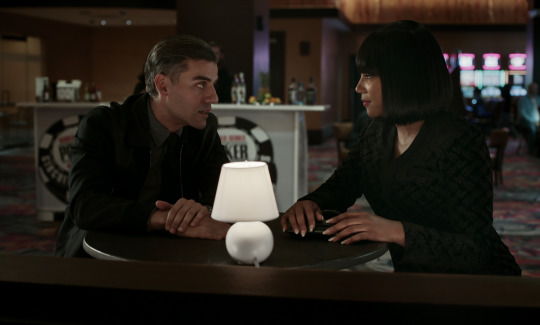
Oscar Isaac and Tiffany Haddish in a scene from ‘The Card Counter’.
There’s an enduring myth that drama is tougher to pull off than comedy, something Haddish’s friend Morris Chestnut corrected her on a few years back. “He’s like, ‘No, what you do, that’s hard work. You are actually overworking yourself, doing these comedies.’ And I’m like, ‘He don’t know what he’s talking about.’ Then I actually did a drama. And I was like, ‘Oh, that was so easy. Oh, that was beautiful.’ It’s way easier. It’s way easier.”
What La Linda doesn’t know, but any casual observer of Schrader’s work will, is that Isaac’s Bill has a past, and that his methodical attempts to keep his guilt in check through a supremely minimal lifestyle, perhaps even to allow himself a spark of pleasure—redemption, even—are about to come unwound.
Before that, though, there’s time for La Linda, Bill and Cirk (Tye Sheridan)—the son of one of Bill’s former, shall we say, colleagues—to become an odd little chosen-family unit as they travel the circuit. Bill and La Linda cook up a nice heat while killing time in cocktail lounges, and her casual business charisma is a charming offset to the deeper themes at play. Writing fresh from a Venice Film Festival viewing, Rahul notes “you keep expecting Haddish to break out of the understated style and that tension works.” Andy agrees: “Her simple outlook on life and lack of existentialism offer a nice contrast to Tell’s brooding sorrow. Plus, La Linda is just a great character name.”

Haddish understood the pull between Bill and La Linda, and La Linda’s desire to probe into his mysterious monotony, in a very specific way: “As a standup comedian, I work with a lot of men that—they’re very talented, they’re doing big things when they’re on stage—but then when they come off the stage you’re like, ‘Who are you? Why are you so dark? Who hurt you? What’s going on?’ I can relate to that in so many ways.”
Still, of all the dramatic writer-directors to work with in America, why Schrader? What was it about his specific brand of lonely-white-man stories that appealed? “Cat People. It’s my jam,” declares Haddish, of Schrader’s 1982 erotic horror reimagining of the 1942 classic (and one of his few films with a female lead, played by Natassja Kinski). “I love that movie. It had some weird, twisted shit in it.” She has been campaigning Schrader to mount a sequel, so that she can have a crack at playing a sexy, predatory jungle cat. “I try to bring it up to him all the time. And he’s like, ‘Tiffany, we’re not doing it. No.’”
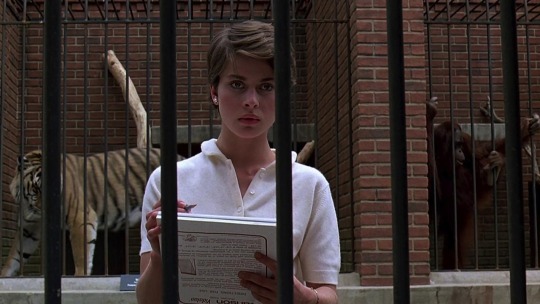
Natassja Kinski in Paul Schrader’s 1982 remake of ‘Cat People’.
Haddish imagines that Cat People would certainly be on La Linda’s list of hotel-room comfort watches, along with Shaft and Goodfellas. Haddish, on the other hand, prefers to kick back with series television when she is on the road. “I watch old sitcoms like Martin or, like, The Facts of Life. I love a good cartoon, especially the throwback ones on Boomerang. I really like the old school, like ThunderCats. That’s a good wind down for me.”
Filming days are long, making the minutes can be stressful, and Covid safety protocols add layers of complexity to the job. There are performers who are cast not only for what they bring to their roles, but also for the energy they bring to set. Haddish has an undeniable magnetism, so it is unsurprising to read her co-star Isaac, in The Card Counter’s production notes, describe her as being “like Jesus”, in that people would drop everything and follow her. She enjoys this comparison, revealing that she has always wanted to be an AD, the crew member with, traditionally, the greatest people skills. “I always wanted to be assistant director just so I can be like, ‘All right, picture’s up, guys.’ And just so I can know everybody and be cool with everybody.”
But as a performer with clout, what is her intention when she—Tiffany Haddish, famous actress™—walks onto a soundstage? Haddish’s answer is a generous primer on how to be a good sort on set (or, indeed, in any working environment). “When I say yes to a movie, that’s a hundred to two hundred people that get to work and I want them to be happy about working,” she explains. “I’m going to work with them again in something else, and I want to have a pleasant experience with the crew. The DP, the gaffers, all these people, we all work together as a unit, so I think it’s super important.”
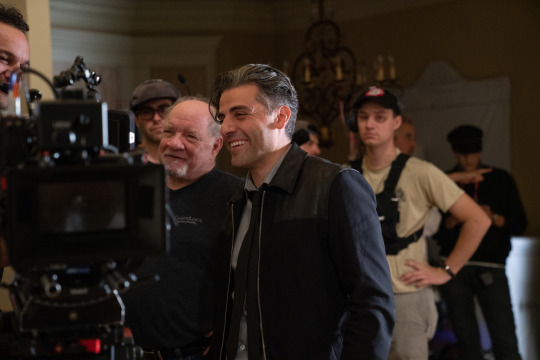
Paul Schrader, Oscar Isaac and crew on the set of ‘The Card Counter’.
Certain crew members, she admits, “are imperative to making me look good”, but more than that, her approach is grounded in her own physical and emotional safety in an often volatile and unpredictable creative environment. “I see how some actors won’t talk to any crew members at all, and I feel like that’s not okay because these people are busting their ass to make you look great, and they are part of telling this story too. They might not be hanging off the side of the building like you are, but they are making sure that the camera’s operating correctly, so you don’t have to shoot it five hundred times.
“These people keep me alive. They keep me going and they can tell when I’m in a bad space. They’re like, ‘Here’s a Snickers.’ If I’m working with an actor who might be treating me not the best, they’re coming over, they’re giving encouraging words, ‘You’re going to be okay.’ We’re a team. I even talk to the editor. They’re like, ‘Picture’s up, sound’s rolling, and speed.’ And I’d be like [staring down the camera lens], ‘What’s up editor? Hey, it’s your girl Tiffany Haddish. Just a little note: I’m thinking about you. Now, if you could just make sure this lazy eye is this way… I know you’re in that room by yourself, but look out for your girl.” Sometimes, Haddish will even throw a bone to the studio executives. “I know they’re watching the dailies,” she laughs.
Her investment in the welfare of her film families is paying off in unexpected turns such as The Card Counter, with more to come. Up next, a trio of unusual comedies: Jerrod Carmichael’s existential buddy farce On the Count of Three, which was picked up by Annapurna out of Sundance this year; Cory Finley’s surrealistic sci-fi romp Landscape with Invisible Hand; and the intriguing Nicolas Cage vehicle, The Unbearable Weight of Massive Talent.
Related content
A list of favorite gambling movies from Gamblers, a podcast from The Big Picture’s Sean and Amanda
Life Detained: Jack Moulton’s interview with Kevin Macdonald, director of The Mauritanian
Josh’s list of Neo-Noir films
Follow Gemma on Letterboxd
‘The Card Counter’ is in US cinemas now.
#the card counter#paul schrader#tiffany haddish#cat people#oscar isaac#tye sheridan#gambling movies#neo noir#girls trip#actress#Black actress#letterboxd#gemma gracewood#morris chestnut#filmmaking tips#goodfellas
11 notes
·
View notes
Photo
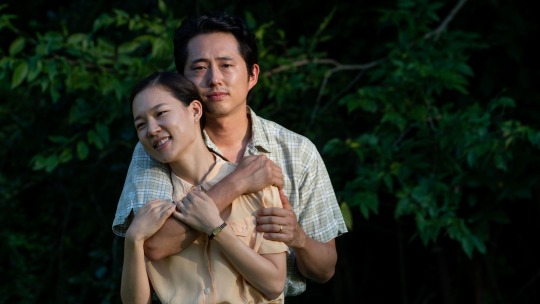
Heart Beat.
Minari’s film composer Emile Mosseri (also responsible for the Kajillionaire and The Last Black Man in San Francisco scores) tells Ella Kemp about his A24 favorites, Nicholas Britell’s friendship and the boldest Paul McCartney needle drop in movie history.
What do you think a broken heart sounds like? How about a warm, beating one? It’s something that Emile Mosseri has been thinking about for a while now. The past two years have seen him complete a hat-trick of beguiling, transporting scores for Plan B movies: Joe Talbot and Jimmie Fails’ The Last Black Man in San Francisco, Miranda July’s Kajillionaire and now, the film voted the best of 2020 by our community, Lee Isaac Chung’s Minari.
What binds these scores together is a delicacy that knows when to break free and turn into something altogether spectacular. But on Minari in particular, Mosseri is in full bloom, working for the first time in a way he’d always dreamed about. While The Last Black Man in San Francisco saw him compose to a loose edit, and on Kajillionaire he worked to a locked cut, Chung gave him the freedom to write music directly to Minari’s script. “It was a dream to work this way on Minari,” Mosseri says. “It was so beautifully written and so visceral.”
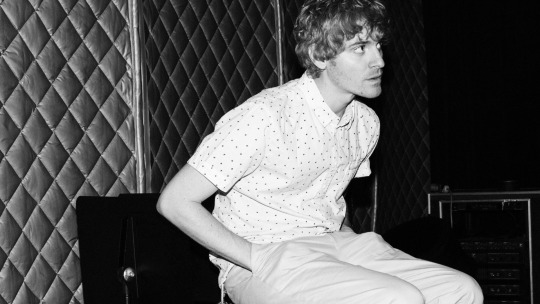
‘Minari’ composer Emile Mosseri.
Minari is an intimate portrait of a Korean family making their way in rural America, and the composer was interested in “trying to figure out musically how you can feel connected to your deepest childhood memories”. These memories belong, in the film, to David—a tiny king played by eight-year-old Alan Kim—as he comes to terms with his new life on a small farm in Arkansas, as his family strives for their own version of the American Dream.
The Yi family is made up of David and his sister Anne (Noel Kate Cho), their parents Monica (Han Ye-ri) and Jacob (Steven Yeun) and their grandmother, Soon-ja (Youn Yuh-jung). It’s a personal story for Chung, one that Mosseri felt honored to be a part of. “It’s a very intimate story with these five characters, which takes place mostly in this small mobile home—but emotionally, it’s very epic.”
There was something about Chung that had caught Mosseri’s attention early on. “I had met him at the LA premiere of Last Black Man,” Mosseri says, “and I sent him the Kajillionaire score.” Mosseri was already familiar with the filmmaker’s work: “His first film, Munyurangabo, is incredible.” He calls Chung “very open, but also sly” in terms of hitting the right notes and “gently steering the ship”. The partnership between composer and director was about working on “a more emotional level,” Mosseri says. “There was never any talk about what we wanted stylistically.”
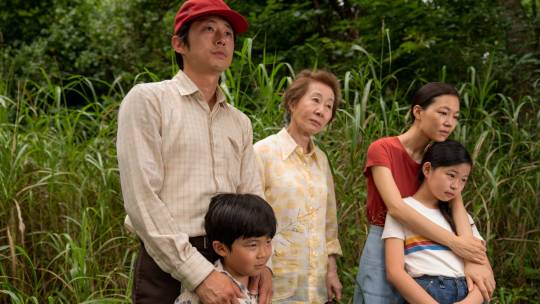
The ‘Minari’ ensemble cast.
The result is a film graced with music at once lush and raw, grandiose and vulnerable. Mosseri is keenly aware of these nuances, and always made sure to walk the tonal tightrope in the writing process. “There aren’t sad cues and hopeful cues,” he explains. “Every cue has both feelings. Each musical moment dips in and out of the hopefulness and joy of a family, and then the pain and frustration and dissonance that they hold.”
The way Mosseri’s music swells and flows often feels intangible, magical, even—which comes more from knowing what to avoid, rather than acting with too much forced intention. On his first film, Mosseri brought brass and strings to the streets of San Francisco, and with Miranda July, he worked old Hollywood glamor into the concrete blocks of Los Angeles. Here, we twirl through the tall grass as gentle acoustic guitars and elegant string sections sigh and sway, while the Yi family work through their growing pains.
“We didn’t want to hear Korean music when you see Korean characters, and we didn’t want twangy music when you see an American farm,” Mosseri explains. “We wanted to come at it from the side somehow, in some way that’s unexpected.” ‘Rain��, his collaboration with Minari star Han Ye-ri, which features on the official soundtrack, encapsulates this juxtaposition. It’s an epic lullaby of sorts; Han sings in Korean to a gentle guitar; a pleasing swell of synths climbs alongside her voice. The effect on the listener is as if liquid love is trickling from every vein. “I wanted this score to feel like it had a warm, beating heart.”
youtube
Two of your three feature films to date have been released by A24, and so we must ask: what are your favorite A24 film scores? Emile Mosseri: Three come to mind. First of all, Anna Meredith’s score for Eighth Grade. It’s so adventurous and unexpected and fresh and just brilliant. It’s so pure and out-there. It also does this impossible thing of being hip and exciting and deep, but also hilarious. The pool-party scene fucking kills me.
Then there’s Under the Skin by Mica Levi. I remember seeing that at the Nighthawk theater in Brooklyn and feeling like it was the best score I’d heard in as long as I could remember.
And then of course, Moonlight. That film got under my skin in a way I didn’t see coming. I saw it by myself in a theater, after hearing all the hype for months and months. When a movie has that much hype you can get a bit cynical and it can distract you, so I went in a bit guarded, but I left the film destroyed. For weeks and weeks it resonated with me in a way that was so profound, and a large part of that is due to Nick [Britell]’s music. And the film is just perfection.

Scarlett Johansson in ‘Under the Skin’ (2013), scored by Mica Levi.
You’ve been described as Nicholas Britell’s protégé more than once… It’s funny, I think that came from me being a fan of his and saying nice things about his music. I met him at Sundance two years ago when Last Black Man was premiering. I went with my wife and my brother and I was so excited, I’d been waiting for this moment for so long. We walked in and Nick and Barry [Jenkins] were walking in behind [us]. And there was also Boots Riley, Kamasi Washington… all these people I looked up to. I hadn’t considered that I would see this film in the room with them, and it was the first time I was hearing the final mix and just agonizing.
Nick was incredibly generous and said great things about the score and was super encouraging, and he became a friend and mentor. But I’ve never studied with him or worked with him. Although, if you’re a fan of somebody’s work, you’re a student of any of these composers that you admire. Anything you watch and listen to, you absorb.
What was the first film that made you want to be a composer? It was Edward Scissorhands. Danny Elfman’s score was the first one that made me realize that this was a job. I’m always attracted to big, romantic melodies, and over-the-top sweeping stuff—but done tastefully. In that score, he sets the high-water mark for me. It’s so unapologetically romantic.
And then there are other obvious ones like The Godfather. It’s maybe a dorky choice because it’s the most famous movie ever, but it really is the best. And that got me into Nino Rota, and from there I found [Federico] Fellini and all these movies through Nino, the composer. And then I got really into the score for La Dolce Vita and more movies that he’d written for, which are so beautiful.
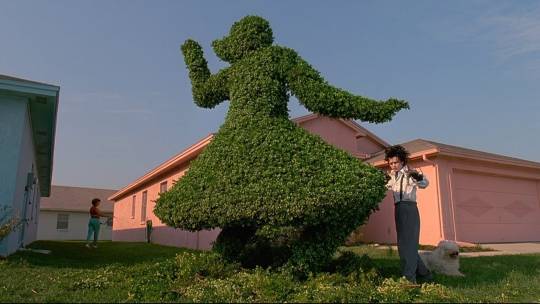
The ‘Edward Scissorhands’ (1990) score was an early inspiration for Mosseri.
Which films, new to you, blew you away in 2020? Take Shelter by Jeff Nichols blew me away. It unfolded in a way that was intoxicating and really exciting, and it just really stuck with me.
What’s been your favorite needle drop on screen this year? Aside from Devonté Hynes’ score being stunning, there’s an amazing piece of music placed in an episode of Luca Guadagnino’s We Are Who We Are. They use a Paul McCartney song called ‘Let Em In’, and they dropped it in this incredibly tasteful but unexpected way, in a really dark, emotionally loaded scene. It worked in such a beautiful and graceful way. It’s because it’s the most cheery McCartney, it’s full-blown upbeat and poppy McCartney. And this is the darkest-of-the-dark human pain, and it lands in this way that is such a bold choice, such a powerful move.
What should people listen to after watching Minari? One record I’ve been listening to a lot recently is Jeff Tweedy’s Love is the King. It could be a good companion to Minari. I’m a huge fan of his and it’s a gorgeous record. It’s very stripped-down and emotionally raw, and it’s both hopeful and heartbreaking.
Which filmmakers would you love to work with next? I’m always afraid to answer this question because there are so many filmmakers I admire. There are filmmakers I grew up with loving their films—working with Miranda was that for me. Spike Jonze or Yorgos Lanthimos are directors in her world that I also love and would love to work with. But there’s so many others. Derek Cianfrance is amazing and he works with different composers. I love his choice of collaborators musically. I love that he used the late great Harold Budd to do his shows [including I Know This Much is True], and then Mike Patton, and Grizzly Bear… the music is always incredible in his projects, but he doesn’t have a go-to person. His films are so heartbreaking and powerful and really, really raw. He’s fearless.
I feel very lucky that I’ve worked on these three films which are all very much like somebody’s ripping their heart out and putting it on the screen. I feel like Derek Cianfrance does that in his films too, in this unapologetic, super-vulnerable way of just ripping his soul out and putting it out for everyone to see. It’s incredibly appealing to find those projects, because they’re really rare.
Related content
The matriarchs of Minari talk to Aaron Yap about chestnuts, ear-cleaning, dancing, Doctor Zhivago and their unexpected paths into acting
Awards Season 2020-2021: our annual list of major trophy winners
The Perfect Score: a Letterboxd Showdown
Follow Ella on Letterboxd
‘Minari’ is available everywhere in the US that movies can be rented, and screening in select theaters in the US and other regions. Listen to the official soundtrack and more of Mosseri’s film compositions in the official Spotify playlist via Milan Records. ‘Kajillionaire’ is available on VOD now.
#minari#letterboxd year in review#kajillionaire#the last black man in san francisco#emile mosseri#miranda july#lee isaac chung#a24#a25 films#film composer#film soundtrack#film score#derek cianfrance#nicholas britell#nino rota#letterboxd
14 notes
·
View notes
Photo

How I Letterboxd #3: Dave Vis
If you are one of the thousands of Letterboxd completists attempting to log every film on our official top 250, you have Dave Vis to thank for keeping that list current. He tells us why he adopted ownership of the list, how he felt when Parasite “dethroned” The Godfather, the curious case of A Dog’s Will, and several Dutch filmmakers worthy of discovery.
You wear your tenure proudly on your profile (“Member since 12/11/2011”). How did you come across Letterboxd way back then? I joined in the beta days when I got an invitation in November 2011 from a good friend who knew I was into film. Up to this date, I have no idea how she got a beta invitation for a movie geek website from New Zealand, but I’m happy she did!
Here’s the $49 question: How do you Letterboxd? I joined because I found it useful to keep track of everything I watched. At that point, I was probably still ticking off films from IMDb’s Top 250, and Letterboxd was a cool way to make other lists and see how I was progressing. When I started using the site more often, I also got to follow more users and enjoyed reading their takes on films. I don’t follow a lot of people, just a few that I know in real life and some other early adopters of the site whose opinions of film I got to value.

Talk us through your profile favorites. What spoke to you about these four films? The pragmatic reason for these four is that they were the last films I watched that got full marks from me. So the four favorites on my profile keep changing as I come across more films that I think deserve five stars. About the current ones: Jaws, of course, is an absolute classic, maybe even Spielberg’s greatest. How he creates that much tension with minimal exposition is masterful. Blade Runner 2049 baffled me, especially on an aesthetic level. I love how the story slowly unravels in probably one of the best world-building efforts of the last couple of years. The Lord of the Rings: The Fellowship of the Ring doesn’t need much explanation, I think. Peter Jackson did what was generally thought impossible and in a way that had me walking out of the cinema in awe of the spectacle and production design. Last but not least, Nausicaä of the Valley of the Wind. I’m a huge fan of the Studio Ghibli films and this one, [as well as] being the studio’s unofficial first, is probably my favorite. You can just tell that they worked years to get Hayao Miyazaki’s life’s work to the big screen.
Let’s get down to brass tacks: for the past six and a half years, you’ve been running the Official Letterboxd Top 250, one of our most popular and important lists. What prompted you to start the list? Did you think you’d be keeping it going this long? At least part of the credit goes to someone else on Letterboxd, because even my list is a cloned one! A great deal of thanks goes to a member called The Caker Baker, who sadly isn’t part of the community anymore, for having the idea of doing this list even before me. On the exact day Letterboxd introduced a sorting option by average rating on the Films page, he created the first top 250 list.
I decided to clone that list [Dave has archived it here], because I wanted to filter out the documentaries, shorts and miniseries. As long as I am interested in film and won’t have completed the list, I do see myself keeping it. I feel the overall quality of the list is outstanding and for my taste and film-watching experience it’s probably the best combination of blockbuster hits, timeless Hollywood classics, non-English spoken gems, and some pretty obscure entries.
What’s involved in keeping the top 250 up-to-date? What’s the hardest thing about it? Have you ever found the responsibility a burden—your ankle chained to Letterboxd each week? (We’re grateful!) These days it isn’t much of a bother at all, actually. I’m still so grateful for you guys introducing the ability to sort lists by average rating when editing them a while back. That was a huge relief, I can tell you! And apart from the odd comment when I’m a bit late on my weekly update or when I’m on a well-deserved holiday (yes, even the ankle chain comes off once in a while), I don’t feel like it’s a burden at all.
Let’s unpack it a bit. What are the best films you’ve discovered because of the list? Shoutout to my choices: A Special Day, Harakiri and The Man Who Sleeps. Harakiri is an excellent choice! If it wasn’t for Letterboxd’s top list, I would probably not even know about it today, although it also cracked IMDb’s top 250 last year. What a beautiful film. If I have to name two other, one would be The Cranes Are Flying. I’ve rarely seen a film about war being depicted so beautifully. The other is It’s Such a Beautiful Day, the animation by Don Hertzfeldt about a stick figure you get to care deeply about in a time span of just over an hour. Very different films that, without Letterboxd, the chances are next to zero that I would have checked either of them out. Joining a Kickstarter to finance my own Blu-ray edition of the latter was special too.
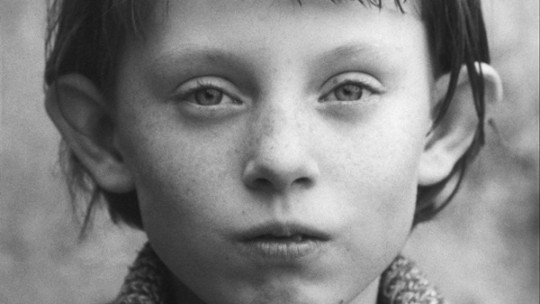
Béla Tarr’s 1994 masterpiece ‘Sátántangó’.
So, what’s your percentage-seen of the top 250? Which films rank highest on your list of shame? Are there any that you don’t think you’ll ever watch? At this moment I’m at 175 of 250, so 70 percent. I rarely consider films as being on a ‘list of shame’, but as I scroll through the unseen ones, there are a few that stand out. La Dolce Vita and Sátántangó [Editor’s note: recently re-released in 4K, nudge nudge] are ones that I feel I should have watched by now. Both are magnum opuses from legendary foreign filmmakers. Don’t really know why I haven’t though, but all in good time. Any that I think I’ll never watch? There’s not much I wouldn’t watch, but some are just so daunting in their runtime, that I’m not sure if I will ever feel up to the task (yes, La Flor, I’m looking at you). Probably also the reason I never popped Sátántangó in.
Has the way Letterboxd’s membership has changed and grown affected what’s in the top 250 in any interesting or unexpected ways? That’s not a very easy question to answer, because different people will be surprised about different things. However, you do see a trend—surprising or not—of traditional western cinema classics giving way to more non-English language films doing well on the list. Asian and Brazilian films have skyrocketed to great heights, often at the expense of western classics. Films that are traditionally doing great at IMDb, such as Pulp Fiction or The Good, The Bad and The Ugly, were in Letterboxd’s top ten for a long time, but have both dropped out of the top twenty. Beloved classics among film critics such as Citizen Kane, Sunrise: A Song of Two Humans and Casablanca aren’t even in the top 100 anymore.
We now have a top ten with three Japanese films, one Taiwanese, one Russian, one Brazilian and a South Korean film at the very top. The only English spoken films left there are the two Godfathers and 12 Angry Men. I do tend to suspect that the growing community causes more diversity while also fuelling the more traditional moviegoers to broaden their interests. I personally think that’s a great development.
How did you feel when Parasite overtook The Godfather to become Letterboxd’s highest-rated film of all time? Do you think it’ll ever sink at this point? To say I was surprised is quite the understatement. For something to even come close to The Godfather’s record borders on sacrilege, let alone dethroning it. What you usually see is that new movies with overly positive reviews enter the list’s higher ranks with a bang, but when they are introduced to a bigger crowd, they slowly descend. For example, fellow acclaimed Best Picture nominees 12 Years A Slave, Her, Call Me By Your Name and Roma all peaked in the top twenty and only Call Me By Your Name is still in the list, at number 232 for now.
In these days of ready availability it is extremely hard to create something that has such a large following. That’s why this takeover by Parasite is so extraordinary. Seeing it rise day-by-day—even after the masses took it in—was something I didn’t think possible. I, for one, am very slow to watch new films, so when I got to watch it, it was already in first position. Safe to say my expectation level was through the roof, which probably wasn’t really fair. While I thought it was an excellent film, I personally wouldn’t rank it among my favorites. However, it’s not only the highest-ranked film on Letterboxd, but also the most popular one [a measure of the amount of activity for a film, regardless of rating]! So don’t expect to see it sink lower any time soon.
The top 250 is home to the largest comment section on the platform. Congrats! What’s monitoring that mammoth thread like? Thank you! Although that’s hardly an achievement on my part. I have to be honest, I don’t read everything in the comments section anymore. I try to keep up as much as possible, in order to respond to people who have an actual question. However, when I sign in in the morning and see dozens of new notifications, most probably about A Dog’s Will being in the top ten or about recency bias or about objective quality versus subjective quality, I let it pass me by every so often.
What is your take on A Dog’s Will’s rise to Letterboxd stardom? (At the time of writing, the 2000 Brazilian film from director Guel Arraes holds the number eight spot in the top 250.) Ah, there it is: the elephant in the room… My honest answer is a politically correct one, but also the truth: I haven’t seen it yet, so it’s impossible to pass judgment. However, from the comments section on the top 250, it seems clear that there are two camps: the Brazilians, who adore the film and continually claim the importance it in their cultural heritage. And there’s the other group, mostly non-Brazilians of course, who think it’s a fine film at best, but in their opinion not deserving of a top-ten spot. I’m quite impartial: if the statistics say that it is one of the best-rated films of the Letterboxd community, why would it not deserve to be there? I am curious though if more non-Brazilians will see it and if so, if that will have a significant effect on its rating. We can only wait and see.
Are there any films you’re surprised to have stayed in the list for so long? Conversely, what are some films that we’ll be surprised to hear have never made the list? If I have to name one film that I’m surprised about, it’s one I haven’t seen yet: Paddington 2. Every time I scroll past it, I find myself asking: “wow, this one still in?” It’s probably because I haven’t seen it, but it always strikes me as an odd one. I really have to seek it out some time. Some films that might shock people never having made it… Well, if you look at IMDb’s list for reference, you could say it’s shocking that a film like Forrest Gump never made it onto the list, but that might not be as much of a shock to Letterboxd members. Other popular crowd pleasers that never made it include E.T. the Extra-Terrestrial, Gladiator, all of Disney’s non-Pixar animated classics, and one of the films that also sparked my interest in movies, The Usual Suspects.
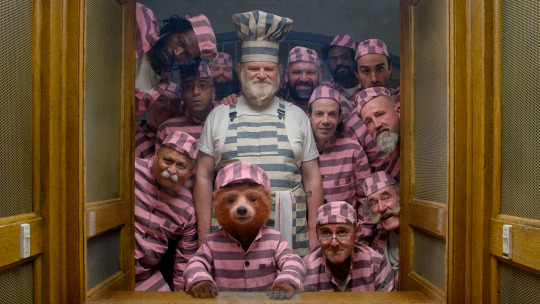
Dave has not seen ‘Paddington 2’.
I’ve actually been working hard on completing the list during quarantine and I finished it yesterday. Has anyone else gotten to 100 percent yet or am I the first? I have no idea, to be honest! There will probably be others who have, but I wouldn’t be able to name one. I suspect Jakk might have reached 100 percent at some point.
My completist streak will need a new avenue. What are your next most essential top lists? If you ever feel up for a challenge, I recommend Top10er’s 1001 Greatest Movies of All Time. He combined the average ratings of critics and users from IMDb, Rotten Tomatoes, Metacritic and Letterboxd, and then weighted and tweaked the results with general film data from several services. I have no idea how, but it’s a terrific list. Also, the directors’ favorites lists that are on Letterboxd are awesome. Edgar Wright’s 1,000 favorites and Guillermo del Toro’s recommendations are especially worth your while.
The top 250 list is the tip of the iceberg for the lists on your account. What is it you enjoy about keeping ranked lists? It’s a compulsion. I just really enjoy making lists, ranking films by certain directors, franchises or studios. Not really useful, mostly just fun to do! And I’m not the only one, it seems. Although, of course, lists like the Letterboxd Top 250 will always be an inspiration for finding well-rated films I haven’t seen yet.
Which films got you hooked on cinema? I do have a few titles that were important in terms of my film-watching development. Films like Terminator 2: Judgment Day and Jurassic Park came out when I was an early teenager and those were the ones luring me to the cinema to see and experience things you just couldn’t in the real world, both with groundbreaking special effects—I’m a sucker for those. Not much later, titles like The Shawshank Redemption and Pulp Fiction were popular and that’s probably around the time that IMDb’s list got my attention. That top 250 gets a lot of criticism, but the overall quality is fine and for me it was the perfect step in broadening my film-watching.
So, for a long time I watched a lot of films on that list and went to the cinema for your usual blockbusters, probably until Letterboxd arrived. That’s when I started watching the artsier stuff and foreign cinema of which, of course, all classics eluded me up till then. It was films like Seven Samurai, Persona and Werckmeister Harmonies that sparked that particular period. Now I just watch everything that comes my way that seems interesting or entertaining, from the new Marvel instalment to classic Godard.
Tell us about the one and only movie you’ve given a half-star. Ha, that’s an odd one… Once there was a challenge on the site that you could ask a fellow member to pick the next ten films for them to watch. I participated once and, of course, there would be underseen gems or personal favorites on that list, but also one or two that would be almost unwatchable. In my list that was Santa and the Ice Cream Bunny. If that title alone doesn’t give away how bad it was, watching the first five minutes will.
In your opinion, what’s the most underrated film according to Letterboxd average ratings? One that comes to mind, which was in the top 250 once, but has dropped substantially in the last few years, is Gravity. I also have a list where I collect all the films that were once in Letterboxd’s top 250 and it’s at the very bottom there. For me, seeing that film in a theater is what cinema is all about—finding new ways to immerse your audience into a movie experience they have never had before. Oh, did I mention I’m a sucker for special effects?
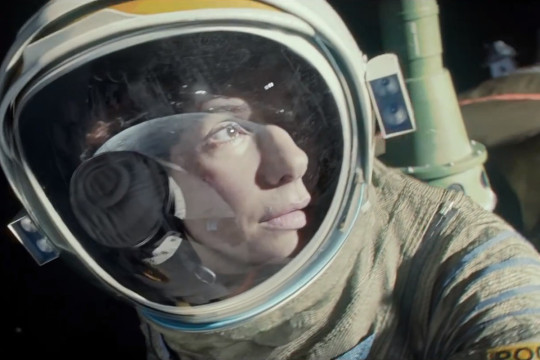
Dave is a sucker for special effects, including those in Alfonso Cuarón‘s ‘Gravity’ (2013).
As a Dutchman, please educate us: what are the greatest Dutch films people should see? The Netherlands doesn’t really have a thriving movie industry that brings its films across borders. If I have to give the essential tip, it would be Spoorloos, which was remade starring Kiefer Sutherland and Sandra Bullock and was not half as good. Other than that I would recommend Paul Verhoeven’s early work, such as Soldaat van Oranje and Turks Fruit, and the two Dutch films that won the Oscar for Best Foreign Language Film, 1986’s De Aanslag and 1997’s Karakter. And to top it off, I want to mention two Dutch filmmakers worth your time, Alex van Warmerdam, director of De Noorderlingen, and Martin Koolhoven, director of Oorlogswinter.
What comfort movies are you watching whilst in quarantine? Are you working on any viewing projects? I actually am in a viewing project at the moment. One of mine and my wife’s guilty pleasures is superhero movies! So currently we are, again, on a Marvel Cinematic Universe rewatch streak. They just provide a wonderful form of escapism and are definitely deserving of the term comfort movies. Some are better than others of course, but the perspective of rewatching The Avengers, Thor: Ragnarok or Guardians of the Galaxy after a while still tends to fill me with excitement. In a way, there’s still a bit of the twelve-year-old in me that was so thrilled to see T2 or Jurassic Park.
How do you plan on inducting your kids into the cinephile life? Well, most important is that they just enjoy going to the movies like I did when I was young. Let’s hope we will be able to do so again in the near future. They are still young, but their access to screen time with Netflix, Disney+ and (mind-numbingly stupid clips on) YouTube is so different than the days when we were young. So having them watch some Ghibli classics is already quite a step. And then I think the rest should come naturally. If not, so be it.
Which, for you, are the most useful features on Letterboxd? Did you know they have a list with the 250 best rated narrative feature films? That’s basically all you need to know��� All kidding aside, just reading reviews once in a while by fellow members whose opinions I value is still the heart of the service to me. That and the statistics pages. And browsing other lists.
Does anyone in your real life know that your list is kind of a Letterboxd big deal? Not really! Mostly because I don’t exactly feel that way about it. I mean: my wife knows, but other than that it’s pretty much still my pet project. To me, it’s still just a film enthusiast’s list that so happened to become the site’s official top 250. I do have to say that it is humbling to see the numbers of new followers every day—especially when Letterboxd mentions the list on her social accounts—and to realize that apparently almost 23,000 people around the globe have taken a liking to it.
Please name three other members you recommend we follow. Fellow countryman and longtime member DirkH. He is not as active as he was before, but writes beautifully personal reviews, always with his trademark witty humor or sometimes cheeky sarcasm, not always to the liking of everyone. You all got to know Lise in the first How I Letterboxd, but I’d definitely also recommend following her other half Jonathan White. His reviews are great, he knows so much about film and is always willing to share his thoughts or answer questions. And damn, that man can rhyme. Then there’s Mook, if only for his franchise lists. Check out his MCU list, it’s my go-to place when I want to read up on anything Marvel.
Related content
Official Top 100 Documentary Feature Films
Official Top 100 Narrative Features by Women Directors
Letterboxd’s ‘Official’ Top 50 of 2020
Several of the films mentioned in this interview—Sátántangó, La Flor—are (at the time of writing) available for virtual screenings. The details are in our Art House Online list.
#letterboxd#how i letterboxd#top 250 films#letterboxd top 250#dave vis#cinephile#film lover#letterboxd members#letterboxd community
4 notes
·
View notes
Photo

The Last Artists.
“From the outside it seems like this dream scenario… but the truth is it took years working on drafts and wondering if anyone would ever read them.” —Joe Talbot on The Last Black Man in San Francisco.
A love story to San Francisco, to one grand Victorian house in particular, and to a life-long friendship, The Last Black Man in San Francisco was many years in the making. And it paid off: Joe Talbot picked up the Best Director prize at Sundance 2019 for his debut feature, a story drawn from the life of his best friend (and the film’s leading man), Jimmie Fails. A close-knit family of creatives grew around the project, and became a vital support system for Talbot when his father had a stroke just weeks before the shoot. Since January, critical accolades for the film have snowballed. Most recently, it appeared in our ten highest-rated features for the first half of 2019.
Letterboxd reporter Jack Moulton took the opportunity for a lengthy chat with Talbot about his remarkable debut feature. The interview contains a virtual masterclass in first-time feature film development (and the persistence required to see it through), along with some never-before-seen images shared exclusively with us by Joe. Also: some plot spoilers, which we’ve left until the very end.

Joe Talbot and Jimmie Fails in 2014, photographed by Talbot’s brother, Nat Talbot.
Thanks for agreeing to a good chat with us. Are you on Letterboxd? We have our suspicions that you might be. Joe Talbot: Yeah. I love it. I found Letterboxd before we shot the movie. I use it to save movies to watch for later and look up movies people recommend. Occasionally I read the reviews of films I’ve just watched, they’re often really thoughtful.
Can we share your username? You could be the next Sean Baker. The one I have right now is more of a lurking profile so it’s not very formal. I made one that’s a little more presentable for you under my name.
Are you in San Francisco right now? I am. If you can hear my heavy breathing, I’m actually walking up one of the steeper hills that Jimmie and Montgomery crest in the movie and see the skyline. That’s what I do for every interview, I like to walk up the hill to put me in the film. Just kidding, this is the first time I’ve done it. I’m just walking with a friend and we’re about two thirds of the way up. Woo!
We’ve just published our halfway top 10 of the year. The Last Black Man in San Francisco is in second place, between Avengers: Endgame and Booksmart. How does this make you feel, and how do you cope with reviews (whether they’re full of praise or criticism)? Wow, that means a lot. I find the reviews informative, though have to admit I don’t read too many of them. In general, it’s great to know that there are people that love movies enough to get into debates and write passionately, either about how much they loved them or didn’t like them at all. Having platforms like Letterboxd and finding those communities online can be really great, even if they’re not made up of people in your city.
Given that the film has relatively low stakes—it’s not life or death, it’s house or no-house—what gave you confidence that audiences would connect to Jimmie’s story? I don’t know if we were ever confident. You never fully know. You hope that if you share something that has meaning to you then it will have meaning to others. That was our guiding light.
We finished the movie four days before the Sundance screening, so that was the first time watching it with any audience. I looked over at [Plan B producer] Jeremy Kleiner when the movie ended; he said “the tweets are good”. I looked around and realized the whole audience were on their phone as soon as the credits rolled.
I only had a short film play at Sundance before [American Paradise in 2017, also starring Jimmie Fails] so I didn’t realize part of our culture now is the need to immediately respond to something—but luckily they were nice. It will be much more anxiety-inducing going into my next feature now that I know how all this works.
We wanted to make something that captured the San Francisco that we grew up in and feel very strongly about. We’ve travelled to Chicago, DC, New York, LA, and Atlanta with the film and I was surprised to see how much people were connecting to it. In a way, Jimmie and I say it is unfortunately universal because it means the same things are happening everywhere.
This idea has lived with you and Jimmie for a long time. Can you talk us through the journey of the film? We’ve been informally talking about it for at least seven years and it’s gone through so many incarnations. We always envisioned it as the first feature that Jimmie and I would make after many years of making short films together. This story felt big enough in scope and there was a lot that we wanted to cover.
We wanted to tell a story about Jimmie and this Victorian home he once lived in and make it a valentine to the San Francisco we grew up in, that we see as being lost. We also wanted to celebrate all the wonderful people who are here that make this city what it is. That’s a big part of what we are afraid of losing: the very people that make San Francisco ‘San Francisco’.

An alternative poster for the film, illustrated by Akiko Stehrenberger.
We both lived with my parents for five years—we ran our operation out of the living room there. The first thing we did was shoot a concept trailer for Vimeo. It was a five-minute piece of Jimmie skating through the city telling his grandfather’s story, much like the [feature’s] opening sequence, though I filmed it hanging out of the side of my brother’s car.
Afterwards we got emails from people saying they wanted to help; they would become our core collaborators on the film. Khaliah Neal, Rob Richert, Luis Alfonso de la Parra, Natalie Teter, Sydney Lowe, Prentice Sanders, Fritzi Adelman, Laila Bahman and Ryan Doubiago. They spent years with us, hashing out the script over my parents’ kitchen table and working with us to create a look-book, run an ambitious Kickstarter campaign, write grant proposals and so on.
We felt like these oddballs—the last artists in San Francisco. You get a lot of noes along the way, having never made a movie before, so it was the emotional support that helped us persist through the difficult times. We were excited to be learning together, as a group of mostly first-timers, and were constantly making things.
Our look-book was very elaborate, thanks to our stills photographer Laila Bahman. We built it as a website and staged the scenes as if we were filming the movie, with costumes and heavy art direction. We knew people we pitched were probably seeing materials from other filmmakers who were further in their careers and probably better writers than us. We knew we needed to show the world of the movie so that executives’ imaginations wouldn’t be running off with thoughts of Michael B. Jordan or Donald Glover; that this is Jimmie and this is the plaid shirt we want him in and this is his Victorian. It’s his story.
That helped us get into the Screenwriter’s Lab at Sundance, but I didn’t get into the Director’s Lab, which I was initially bummed about because I really needed that experience. Our Kickstarter was very successful and those backers created a grassroots ground-swelling around the movie that pushed it forward, even though it was difficult in pitch meetings as we weren’t the most bankable pair in such a risk-averse industry.
In a last-ditch effort, my crew and I decided to do our own Director’s Lab instead. We felt if it doesn’t work now then that might be it for Last Black Man. I’d never made a proper short with a budget before but a producer named Tamir Muhammad, who had a short-lived venture within Time Warner called OneFifty, gave us the money to make what would become American Paradise. It gave the crew a chance to get in the trenches together before moving on to a feature, and show the potential of what we could do.
The team who’d assembled from our concept trailer years before all worked on American Paradise, from Khaliah Neal, Rob Richert and Luis Alfonso down the line. We worked with production designer Jona Tochet and even the sound team of Sage and Corinne (who would all go on to work on Last Black Man). In a city increasingly devoid of artists, we felt we’d found our people.
The short was different from Last Black Man, but features Jimmie playing the same character. After it played in Sundance it got the attention of Plan B’s Christina Oh. They took a big leap of faith on us, only having ever made that short. There’s not a lot of people willing to do that.
Khaliah, Christina and Jeremy approached A24 and we were in production two months later. From the outside it seems like this dream scenario of having the incredible indie studios Plan B and A24 behind us, but the truth is it took years working on drafts and wondering if anyone would ever read them. I think the extra time we had helped, because if we had the chance to make it two or three years ago, I don’t think we would have been ready.

Jimmie Fails and the creative team behind ‘The Last Black Man in San Francisco’ at the 2019 Sundance Film Festival. / Photo: Sue Peri
What was the first movie you made with Jimmie when you were teenagers? The first half-decent thing we made was a movie that my brother and I co-directed called Last Stop Livermore. I am actually in it alongside Jimmie and that was my first and only time in front of the camera. I learned my place pretty early on.
Didn’t you have a cameo in Last Black Man? I swear I saw you. I did have a cameo. As long as I’m not speaking, I’m okay. But even then when I just had to look at Jimmie once it was very difficult for me to do. I needed four takes for that shot, ha ha. I’m much more comfortable on the other side.
Jimmie, however, was really good in [Last Stop Livermore]. We made it while I was in high school before I dropped out, and it got into the San Francisco International Film Festival. Like everything we do, it’s based on something that happened in real life when a friend and I felt like we were fish out of water, going off to meet some girls in the suburbs.
That attention the film got, however minor, encouraged us because until that point only our family, friends and my high school teacher had seen our movies. Oh and Jimmie still had a flat-top—just thought I should add.
The film features the most important house of the year [Editor’s note: at least until the rest of the world sees the Parasite house, designed by the great Namgoong]. How did you find Jimmie’s house and what made it the house? It took us over a year and a half to find the house. We combed the streets with my co-producer Luis Alfonso de la Parra and production designer Jona Tochet and knocked on doors. In hindsight, a more efficient way would have been to use Google Maps but this way we could see inside the houses.
Unfortunately, the interiors would usually be gutted and have IKEA furniture and granite table tops. As a filmmaker, it was depressing, but as a native San Franciscan it was heartbreaking because the details inside all these beautiful houses were destroyed. It’s a thing that a lot of real estate agents do when they flip houses.
We ended up going back to a house that I had driven past as a kid on my way to elementary school. My mom, my brother and I would pick out our dream Victorian houses on our family car ride since we couldn't afford a proper one. I went back to one of the houses that had always stuck with me. After we found that house, it felt like we had cast a major character in the movie.
When we first knocked on the door of the house that would become Jimmie's home in the film, an older gentlemen greeted us and within seconds beckoned us inside. As we entered, we found a home that had not been gutted, but instead had been lovingly restored. Jim, the homeowner, much like Jimmie, the actor, had spent more than half of his life working on the house.
He carved the witch hat you see in the movie shingle by shingle and did the honor of putting it on the roof himself. He fixed the organs you see in the film and built Pope's hole in the library. In many ways, he felt like the spirit of San Francisco.
As a now elderly man, we would have understood him declining our wants to film there -- or charging a buttload to help him in his retirement. Instead he welcomed our big crew into his house and charged us next to nothing. I still don't fully know why, but I can imagine he saw shades of himself in Jimmie's love for this Victorian.
In the years we spent location scouting, we would also meet people on the street that we put in the movie. Dakecia Chappell was working at a Whole Foods in the confectionery section, near a ‘potential Jimmie’s house’ around the corner and she was just really charming, so I offered her the ‘Candy Lady’ part in the film. We met the mover who tells Jimmie the homeowners are moving out late one night at a taqueria on Mission Street. This extra time allowed us to capture the little details of what our San Francisco is like.
Even after your major backing from Plan B and A24, was there a point on set where it felt like everything was falling apart? I’m sure there are directors that aren’t plagued by the self-doubt I had. I didn’t go to film school and I felt isolated in San Francisco since a lot of the filmmakers have left for Los Angeles or New York. I was feeling this imposter syndrome. You’re both really joyous and grateful that you finally have a chance to make a movie, but also feel the weight of the city and wanting to honor what’s happening to people there. In every stage you have big and little freak-outs. The only thing that got me through it were the people around me. They bring perspective when you might not have it.
A couple of months before we shot the film my dad had a stroke. He survived, thankfully, and he would say half-jokingly “I survived to see the movie”. My parents struggled as artists themselves in their lives and yet they created this loving home that allowed us to make the movie. I look up to my Dad a lot, so when that happened that was really scary, and it happened during the height of the pandemonium of prep.
By that point our creative collaborators felt like family and they did everything for us. They came over to my house, brought us food, did as much as they could to take work off my plate so I could be with my own family. That always sticks with me when I remember tough times. You could say it’s just a job, but they treated it like so much more. So while it sounds corny, I think the spirit which comes with people being so loving and kind becomes imbued in the film.
Very glad to hear your dad is okay. The scenes with Jimmie’s parents are so powerful; you really get a greater sense of his isolation. It’s amazing his mom agreed to be in the film as a fictionalized version of herself. How did you and Jimmie sketch those scenes? The scene with his mom is loosely based on something that happened. Jimmie was raised mostly by his dad and he’s very close to his parents now in a way that’s very different from the relationship that he had with them growing up. He and his dad have worked through a lot.

Jimmie Fails as Jimmie. This and the header photo are by Laila Bahman.
It’s hard to pack in all the complex details that makes someone who they are because you don’t have enough screen time to do that sometimes. These elements were pulled from the walks we’d take during the earliest developments when the idea was more informal and we’d talk about Jimmie’s family.
One story that Jimmie always recalled both humorously but also quite painfully was about the guy who had driven off in the car that he and his dad were living in at the time. We thought it would be funny if there was a character who never acknowledged that he’d stolen the car but claimed that he was still borrowing it. We knew Mike Epps would be the perfect person for that. It was a story that came from a kernel of truth but took on a life of its own.
Why was Jimmie’s dad pirating The Patriot, of all movies? The tonal juxtaposition made us laugh. Ha ha, it was in the public domain.
We loved the score. What are some of the soundtracks that inspired you while making the film? The Last of the Mohicans, The Day of the Dolphin, The Claim, Batman (and also the animated TV show’s score actually rivals Elfman’s), and Far From the Madding Crowd.
You’ve spoken in another interview about how you and Jimmie fear friendships like yours aren’t possible with the type of gentrification that’s going on. However, nowadays you can meet some of the important people in your life over the internet. Could the bonds we make online compensate for what’s being lost on the streets? I think the internet is a double-edged sword. It both brings people together that you could never have met, such as how many of our closest collaborators first found our concept trailer online. But I do fear it also plays a part in people developing shallower, less intimate connections. I have friends who I love who will go to events seemingly just to get a good Instagram photo out of it. I’m sure I’ve suffered from similar instincts. That scares me.
Montgomery adds so much tenderness and insight to the film. Given he’s Jimmie’s best friend and he’s also an artist, is he your avatar in the movie? How did the casting of Jonathan Majors inform the development of his character? Montgomery is actually not based on me. Jimmie and I have a friend from the Bay named Prentice Sanders who is one of the more original people we’ve ever met. His spirit influenced the first shades of the character. When Jon came on he took those early sketchings to a whole new level, creating his own backstory, mannerisms, and interests.
On the vanity in his room, Jon decided to put up Tennessee Williams, August Wilson, Barbara Stanwyck, Canada Lee, Richard Wright and Ralph Ellison as inspiration. He had a hand in every little detail. In fact, Jon and Jimmie became very close in real life. They still talk nearly every day.
Warning: the last section of the interview contains spoilers, including for the endings of both ‘Last Black Man’ and ‘Ghost World’. This is your last chance to back out…
How do you direct Jimmie? I imagine you can read each other’s minds at this point. Yeah, there is a weird unspoken connection between us, as we grew up together. Knowing each other for so long allowed us to be vulnerable around each other. As a director, inevitably there are days on set that are stressful, scary, and tense, so being able to go for a walk around the block together to recalibrate and feel present was helpful.
This film asked something much different than anything we had done before. We’d never written a feature script and most of our shorts were ad-libbed. Honestly, everyone broke their backs to make this. Cinematographer Adam Newport-Berra was a hero. Nobody phoned it in.
But more than anybody, we asked the most of Jimmie. There’s a scene where he’s across from his real mother and the bravery from both of them to do that set a tone that everyone on set sought to honor.
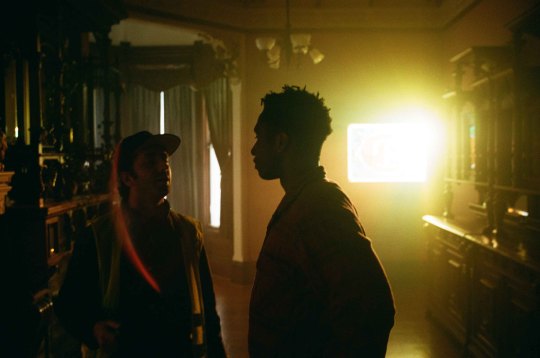
Joe Talbot and Jimmie Fails on the set of ‘The Last Black Man in San Francisco’. Photo by the film’s cinematographer Adam Newport-Berra.
Your collaboration with Jimmie has been so strong for such a long time. Is it a relief for you or maybe a sadness that this phase with him is nearly over? It doesn’t feel like it’s over yet, but I’m sure when it does there will be a little bit of sadness. The movie continues to sell out theaters on a Wednesday afternoon in San Francisco and opened in the little neighborhood theaters that indies barely make it into and it's playing alongside Toy Story. There’s a feeling in the city now that’s hopeful.
It’s been wonderful to witness because I feel like we’ve been working through our feelings about San Francisco in making the movie, and in some ways Jimmie leaving at the end feels a bit like us, how perhaps we can’t be here anymore. I’ve only ever lived in San Francisco my entire life but maybe it is time to go somewhere else.
However, in putting the movie out there I’ve seen so many more natives that feel like people I grew up with 15-20 years ago. People who I thought had been lost but are still out there, fighting to exist somehow through all the changes. I feel like part of me is falling back in love with San Francisco again and I think that feeling is going to go on for a long time.
A lot of people are contacting us saying that they left the theater and they just started writing their own scripts, or writing poetry, or sending us paintings that were inspired by the movie. In a city that is increasingly difficult to exist in as an artist and not always inspiring, this always means something to us.
On the film’s ending: to you, where is Jimmie going? Jimmie is going to start his legacy somewhere else—to fully be himself and start anew, following the footsteps of his grandfather. And it’s more fun to shoot it that way than have him ride away on a BART train.
One interpretation of the ending we’ve heard is that it was all in Mont’s head, and in “reality” it ended on a more tragic note. So some viewers felt it as hopeless, but you in fact intended it to be more hopeful? I think we wanted to leave it open to interpretation. I talked to Thora Birch [who has a small role in Last Black Man] about the ending of Ghost World, because that always left an impression on me. I interpreted it as a suicide when I saw it as a teenager and she had told me that she felt that way about it too, but there are also people who thought she was going off to art school. I feel our ending works in the same way.
I don’t see any interpretation of it as invalid, but what your relationship is to your city affects what you bring to it. Either way it’s a bittersweet ending, because it is a loss for Jimmie and Mont’s friendship, and for the city. Like, San Francisco doesn’t deserve him anymore.
Discover the films that inspired the look and feel of ‘The Last Black Man in San Francisco’.
#the last black man in san francisco#joe talbot#jimmie fails#danny glover#san franciso bay#gentrification#sundance#sundance2019#letterboxd
13 notes
·
View notes
Text
The Greatest Year in Horror Film History PART I: 2017
New Post has been published on https://nofspodcast.com/greatest-year-horror-film-history-part-2017/
The Greatest Year in Horror Film History PART I: 2017
Question: What is the greatest year in horror film history?
Answer: LOUD SCREAMING
I don’t blame horror fans for the passionate debates we get into. It’s almost impossible to be totally objective with a question like that. The most important and invaluable aspect of art is its subjectivity. It creates the possibility for different viewpoints, allowing for discussion and (sometimes) healthy debate. Every person, whether they mean to or not, has an opinion on the pieces that they come across. Sometimes, however, this debate can spiral into a cycle of nastiness that prohibits the free expression of ideas and views.
Horror is no exception. We watch, discuss and rate each movie that we watch, trying to determine its place in the pantheon of great horror cinema. Websites such as Rotten Tomatoes and apps like Letterboxd allow us to share our thoughts and start discussions with other fans about the merits of each film we rate. The problem with these discussions, however, is the very subjectivity that makes art so important. No one can be either “right or wrong”. The conversation often devolves into name-calling and hurt feelings, effectively shutting down our willingness to share our views in the first place. What we need, as a community, is to answer some of these questions once and for all so that we can get back to discussions about how to improve the genre.
You’re in luck, Fiends! We have taken the numbers into consideration and come up with a definitive answer to the question on everyone’s mind at the end of the year. Which year, officially, is the greatest year in horror film history?
OUR METHODOLOGY OR: HOW WE LEARNED TO STOP WORRYING AND LOVE EXCEL
Here’s a quick rundown of how the rankings were decided:
We took a look at all of the horror films from 1970 to 2017. (The early 1970’s were a starting point for us because A) We needed one and B) The frequency of quality and iconic horror films really picked up during this time).
To determine a “score” for each year, we took a look at 5 different rating sources-
Rotten Tomatoes Tomatometer Score
RT Critic’s Average Rating
RT Audience Score
RT Audience Average Rating
IMDB Viewer Ratings
– These ratings were averaged to find the “Fiend Score” for each film. We then combined the Fiend Score of the top three horror films from each year to give that year a total. I admit, the selection of the top three films was sometimes difficult. It was necessary to take other factors into account, such as the size of release, box office total and iconic status to determine which films were included in the top three. These three films were totaled and given an official number which we are calling its “NOFS Score”. These NOFS Scores ranged anywhere from 142 (Ouch) to 255.
Over the next few weeks we will be counting down the years and finally reveal, once and for all, the Greatest Year in Horror Film History! This week, we will be discussing-
#3- 2017
NOFS Score- 239
Several journalists and publications, most notably The New York Times Magazine, have dubbed 2017 “The Year of Horror”. It was a blockbuster year, for sure, with horror films raking in over $1 Billion at the box office. Our official ranking, however, places 2017 at number three. How did we end up with this score? Here are the film with the top three Fiend Scores for 2017:
#3– Split
Written and Directed By: M. Night Shyamlan Starring: James McAvoy, Anya Taylor-Joy
Fiend Score- 73
As a devoted Shyamalaniac (TM), I couldn’t be happier about his resurgence these last few years. The Visit (2015), while not my favorite film of his, definitely showed that he is still very effective within the confines of a low-budget horror movie. Split was a huge success, bringing in over $278 Million for Blumhouse Productions, and it brought us one of the most satisfying closing scenes of the year.
James McAvoy and Anya Taylor-Joy’s performances make this film the joy to watch that it is. Without their work to back up the story, this film quickly turns into just another “girls trapped by a psycho” movie that we would have quickly forgotten about. Anya’s Casey deserves to be placed in the upper echelon of horror “Final Girls” because of her survival instincts and the quiet strength she shows in the face of a monster. With the confidence that he displayed in Split, I have no doubts that Shyamalan is back and will crush next year’s Glass.
#2– It
Directed By: Andy Muschietti Written By: Chase Palmer, Cary Fukunaga and Gary Dauberman Starring: Bill Skarsgard, Jaeden Lieberher and Sophie Lillis
Fiend Score- 80
Here lies my favorite horror film of the year. The first chapter of the new adaptation has grossed a staggering $695 Million at the worldwide box office, making it one of the top grossing films of the year. It has been written about extensively all over Nightmare on Film Street, so going over what the film is about is a bit redundant. Instead, let’s take a quick look at what made the film so successful.
Nostalgia can either be your best friend or it can be the death of your project. The expectations surrounding this film were immense and there was very little room for error for Muschietti and company. What stood out to me was how much of Stephen King’s vision the director was able to get on the screen. Yes, plot points were changed, scares were either combined or replaced and character roles were altered, but the essence of the story was left intact throughout the film. It did not focus solely on Pennywise (interpreted and played beautifully by Bill Skarsgard), but instead followed our Loser’s Club as they each dealt with the Clown and the demons in their personal lives. It was a film that reminded us all about how important those early friendships were, and helped us all to remember those that helped us fight the Dancing Clowns in our own lives.
#1– Get Out
Written and Directed By: Jordan Peele Starring: Daniel Kaluuya, Allison Williams, Bradley Whitford
Fiend Score- 86
It may have been my favorite, but Get Out was the most important horror film of 2017. Jordan Peele delivered, in his directorial debut, a tightly-wound thriller that not only delivered the scares, but also started important conversations about race relations in the United States. The film featured a standout performance by Daniel Kaluuya and grossed a very impressive $254 Million at the box office.
The most effective parts of Get Out happened before we even knew what was going on in the film. We obviously knew that something was amiss with the Armitage family, we just weren’t sure what it was yet. It has been years since I have felt as uncomfortable as I did during the outdoor party scene, and it was my favorite horror moment of 2017. The interactions between the older guests and Kaluuya’s Chris were dripping with subtle racism, whether it was how they changed the way they spoke in front of him or the need for one of the guests to mention Tiger Woods. These interactions can be brushed off as out-of-touch old folks just being uncomfortable, but then the bidding begins.
It will go down as an iconic moment in horror history and we are all lucky to have been able to experience it. Get Out is not only the film with the highest Fiend Score of 2017, but it has an extraordinary effect on everyone that watches it. It forces us to look inside ourselves and assess how we treat the people of color in our lives. The comfort bubble that sometimes surrounds us was burst open and we were able to see how our behavior effects people different from ourselves. This is a rare thing in horror, and I hope that more films moving forward are able to comment on social injustice as well as Get Out.
HONORABLE MENTIONS:
Both Annabelle: Creation and Happy Death Day were close to cracking the top three films of the year. They finished with Fiend Scores of 68 and 67, respectively. I feel like both films are still required viewing, however, especially the scarecrow scenes in Annabelle.
It Comes at Night sported the second-highest Tomatometer Score of the year, but it was also the recipient of the Newly-Created-By-Me “Garbage Day” Award for the film with the largest disconnect between the critic and audience ratings. The Tomatometer score for the film was 88%, but the audience score dropped down to 43%, a difference of 45%! This is less an indictment of the film itself and more of a failing grade to the studio for marketing it as something it was not. Apparently nobody at A24 learned from their marketing mistakes with 2016’s The Witch.
Join the Discussion:
Let’s start a constructive conversation! What do you think about 2017 being the third Greatest Year in Horror Film History? Is it too high? Too low? Which years do you think will rank above it? Join our official Facebook Group and let us know! Stay tuned to Nightmare on Film Street and we will be posting the top-two years over the next two weeks.
#2017#2017 horror#Andy Muschietti#annabelle creation#film history#get out#greatest year in horror movie history#happy death day#horror#horror film history#horror lists#it#it comes at night#Jordan Peele#m night shyamalan#split#the visit
0 notes